October 11,2018.
By Grant Keddie.
Small Spindle Whorls in the Ethnology Collection of the Royal BC Museum
Much of the attention in the literature has focused on the large spindle whorls used by speakers of languages in the Salish linguistic family on the south-eastern coast of British Columbia. In the 19th and early 20th centuries, small spindle whorls were found among peoples belonging to several of the larger linguistic families. The lack of iconography on most of these smaller spindles likely contributed to their being of less concern to researchers than the study of the larger whorls – many of which have geometric, anthropomorphic or zoomorphic design patterns.
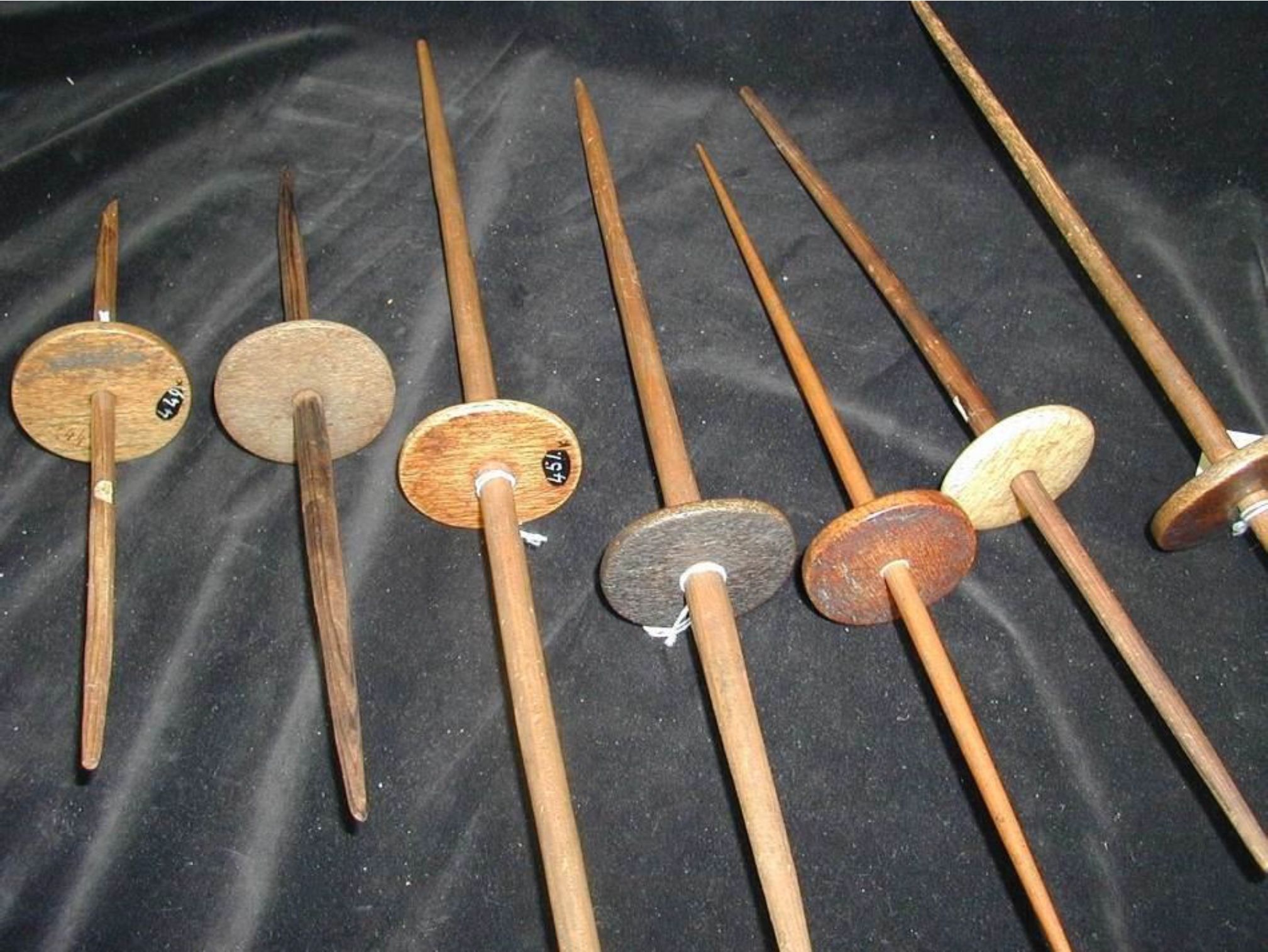
The resurgence of indigenous weaving with the use of large spindle whorls in recent times has focused primarily on the use of animal wool. It earlier times the small whorls were primarily used for producing finer and longer threat made from stinging nettle. Stinging nettle thread would have been mass produced for the making of fish and bird nets as well as for a general tying string. Given that small whorls were introduced before the larger whorls, suggests that the earliest introduction of whorls into this region of North America was primarily related to the procurement of fish and birds. Although other plant fibres, such as fireweed, were likely used in earlier times, the use of animal hair and sinew along with plant fibres and bird down for clothing was probably a feature that developed later in time among some populations.
Morphology and Function
Most spindle whorls fall into two distinct sizes with a limited size range that we can refer to simply as large and small. The 20 smaller whorls in the RBCM ethnology collection range in diameter from 48mm-94.4mm. However, the upper range is biased by the three wooden whorls that range from 67-94mm. The diameter of the 17 sea mammal bone whorls ranged from 48mm-79mm. Wooden whorls are lighter than bone whorls and need to be larger to be of equivalent weight. The size of the hole in the whorl is related to the size of the whorl. Although the diameter of the central hole of the whorls ranges from 8mm-13mm, the smaller 48-65mm whorls have holes with a smaller range of 8-9mm.
The weight of the whorls in the RBCM collection can only be measured on ten whorls that are removed from their spindles or do not have associated spindles. The weight range of the 10 whorls is 16.6 – 45.9 grams. Where whorls were attached to the spindle, weights were taken of the combined elements of whorl and spindle. The range of the latter was 43.9-64 grams. The length and weights of the spindles used with small whorls was much less than those used with the larger whorls.
Regional samples are not large enough for any definitive comparisons, but comparing the more common sea mammal bone whorls, the three from the northern coastal regions are the larger in diameter range from 69.5-89mm. The five Heiltsuk examples range from 59-77mm, the three Nuxalk examples from 49-68mm, and the Kwakwala speakers six examples have a range of 48-69mm.
As a comparison, the seven bone whorls from Kwakwala speakers in the American Museum of Natural History have a similar diameter range as those in the RBCM of 40mm-80mm in diameter. Of the eight examples of Nuxalk small whorls in the Canadian Museum of History, three bone ones range from 50-64mm and five cedar ones range from 71-90mm. The five cedar Gitksan examples range from 59-95mm and two Tsimshian ones from 62-67mm. The one bone Nisga’a example conforms to the smaller size at 53mm. Two “central coast Salish” bone whorls in the Burke Museum range from 63-72mm, with a single stone Cowichan example being 50mm.
Sometimes the ethnographic literature is unclear about whether the smaller or large whorls are being referred to. Museum records may also have incorrect information added long after the whorls were collected – confusing the uses of small and larger whorls. Some small whorls were occasionally placed in ethnographic collections when, in fact, they were found in shell middens. In museum settings one needs to be aware that wool may have been added to museum spindle whorls for display purposes that were not part of the original purchase.
The size of spindle whorls differs according to the size and weight of the required thread. Most spindle whorls cluster into a standard small size and another grouping of larger varieties. The use of a small spindle whorl imparts a higher degree of twist and produces a finer and stronger thread than can be made with the larger spindle. It is for the latter reason that small whorls were primarily use for producing the finer threat made from stinging nettle. Stinging nettle thread was mass produced for the making of fish and bird nets.
The important considerations in the functioning of a spindle whorl are its weight or mass and its radius. The shape of the whorl and how its mass is distributed is also important. A spindle whorl with a lenticular cross section is thinner at the edges and will therefore have less inertia in its spin. A whorl must move at a constant speed in order to produce the best uniformity in the material being spun. The radius of the whorl and size of the spindle shaft will determine the size and weight of the fibre ball that accumulates on the whorl. For a technical functional analysis of spindle whorls see Barber (1991) and Loughran-Delahunt (1996).
In using the small spindle whorl, the yarn was fastened to the longer end of the spindle. A person sitting on the ground drew out the yarn with one hand as it was twisted and with their other hand rolled the spindle shaft below the whorl rapidly down the thigh or shin.
Ethnographic collections of small spindle whorls are found among the Nisga’a, Haida, Haisla, Heiltsuk (Bella Bella), some Tsimshian speakers, Nuxalk (Bella Coola), Kwakwala speaking peoples and Nuu-chan-nulth peoples. There are no examples of small whorls in the RBCM ethnology collection from First Nations that belong to the Coast Salish linguistic family. Larger spindles from the latter region will be dealt with in Part 3 of this series. The RBCM collection does have archaeological examples of small spindle whorls from the latter area (see Part 1).
Practices & Materials Used
The ethnologist Franz Boas documented information on spinning and spindle whorls in the 1886 to 1897 period. He focused his attention on the Kwakwala speaking peoples of North-Eastern Vancouver Island and the Nuu-chan-nulth peoples of the West Coast of Vancouver Island, who he saw as being less affected by European culture at the time.
Boas’s First Nation consultants described four different sizes of spun thread that were used for different purposes. The method of free-dangling of the whorl was not practiced in British Columbia in the historic period.
Small spindle whorls are mostly made of sea mammal bone. Boas describes most spindle whorls from the west coast of Vancouver Island as being made of whale bone, with a few of wood and stone. Small spindle whorls in the Berlin Museum from the west coast of Vancouver Island have geometric and realistic designs. Among the “Kwakuitl”, Boas did not observe any with designs (Boas 1909:373-374).
Boas (1909:372-373), describes in detail the making of twisted stinging nettle string which is coiled up in a basket and then spun. His figure 67 shows a 34cm long, quarter section maple wood spindle shank with a small whorl attached near the thicker middle. He notes:
“The spindle-whorl is made of bone of whale, the anterior part of the skull-bone being preferred. It is ground down on a gritstone. Then it is polished, and finally rubbed with deer tallow. The size of the spindle-whorl differs somewhat, according to the size of the thread to be made. The sizes of those in the Museum [Berlin] collection range from 7cm to 8cm. in diameter. They are not decorated. Many of the spindle-whorls from the west coast of Vancouver Island (Fig. 68) are decorated with geometrical and realistic designs. Most of these are also made of bone of whale, while a few are made of wood and of stone.”
Boas notes that his figure 68a “corresponds in style to other decorated tools of the Nootka”. He states that: “it is remarkable that the spindle-whorls from this whole region are all small, while spindles used by the tribes of the Fraser River region are very large”.
Carved figures of humans and animals are rare on small spindle whorls. Boas’s figure 68, is reproduced here as Figure 2. His figure 68a shows a squatting human with the central hole for the spindle through the centre of the figures chest. The figure is cut out within a solid ring forming the outer portion of the whorl. This figure is reminiscent of some of the later larger whorls from south-eastern Vancouver Island with human figures around a central hole. Three of the top row images and one of the bottom images show the designs that Boas refers to, while the plain ones on the bottom row are typical of the Kwakwala speakers of North-eastern Vancouver Island. These same whorls are incorrectly referred to as being from the “Lower Fraser River” in a later Boas publication (1955:371; fig. 296, p.283).

Washington State. Uses of the Spindle Whorl.
In reference to the southern coast, James Swan notes that the women “spin the thread and twine for making nets. This operation is performed in a very simple and primitive manner by twisting the strands between the palm of the hand and the bare leg … these cords, when spun, are tied up in hanks of thirty or forty fathoms each, and carefully stowed away for future use. The men make the nets” (Swan 1969:163-164).
The nets “are made of a twine spun by themselves from the fibres of spruce roots prepared for the purpose, or from a species of grass brought from the north by the Indians. It is very strong, and answers the purpose admirably. .The nets vary in size from a hundred feet long to a hundred fathoms, or six hundred feet, and from seven to sixteen feet deep” (Swan 1969:104).
Newcombe notes: “String is made by joining strands of nettle fibre by rubbing them on the thigh and then twinning them together by means of a small spindle-whorl.
Sometimes these are carved with a crest of the owner” (Newcombe 1909:37). Unfortunately, Newcombe does not give any specific examples of whorls with iconography that represents an owner’s crest.
Ethnologist Wayne Suttles noted, from information collected in the 1950s, that among the Central Coast Salish speakers:
“Weavers also made a fabric of yarn produced by mixing waterfowl down with nettle fibers, and they made pack straps by twinning on suspended warps, incorporating some of the design elements seen in the blankets” (Suttles 1990:462). There is no mention here of the size of the spindle.
Suttle’s First Nations consultant Julius Charles (born about 1865. Father Semiahmoo and mother Lummi) noted that during winter hunting men wore a buckskin jacket over a bird down and nettle fibre undershirt (Suttles 1974:262-265).
During his field research in Washington State in 1925-27, Olson interviewed five Quinault First Nation consultants that were all over 60 years old, with one, Bob Pope, being over 90. Olson was informed that there were four sizes of nettle thread. Netting was made from two of these threads spun together. The same method was used for the Mt. goat and yellow cedar (Olson 1936).
“The familiar rabbit skin blanket of western North America was also made. T he skins were cut into strips and these twisted hair side out, a spindle being sometimes employed. The strips were either woven as a simple cross weave or, probably more usually, used only as the warp, the weft consisting of elk sinew threads twined in at intervals. The skins of ducks were sometimes cut into strips, which were twisted and woven in the same fashion as the strips of rabbit fur” (Olson 1936:82). No mention is made if different sizes of whorls were used for the production of different materials.
Olson refers to the sheared dog hair being placed into “a cleft stick to keep the hairs aligned”. Here he clearly describes the use of the larger whorls: “Twisting of this hair into yarn was done simply with the fingers (Pope) or by means of a spindle which was rolled down the thigh. The spindle was eight inches or so in diameter (210-220mm). A third informant stated that a spindle (without whorl) which had a hook at its tip was used to pick up the tufts of hair out of the split stick, the spindle being merely twisted by the fingers of the right hand. The yarn was then rolled into balls. Few (or none?) blankets were woven with both the warp and weft of this yarn, twisted elk sinew being woven or twined in as the other element” (Olson 1936:82).
Nuu-Chan-nulth of the West Coast of Vancouver Island
It is unclear whether small spindles were being used among some Nuu-Chan-nuth peoples in 1792. Don Francisco Mosino observed the women at Yuquot “are mainly engaged in the sedentary occupations of spinning and weaving”. But he then suggests that they do not have spindles in his reference to “distaffs”. He points out that: “They have no distaffs except their teeth and fingers, with which they bind together cypress [cedar] fibre and otter hair in order to form a thick plait. This they then make thinner and longer, until they have a skein about a foot long. They use the most simple looms, making a warp out of a cane set horizontally at a height of four and a half feet from the ground; they move their fingers along it rapidly in different directions and with extraordinary skill, making up in this way for the lack of tools which would in any other case be necessary and indispensable for this work.” (Jane 1971:107).
Drucker, working among the Nuu-Chan-nulth (1951:94), notes that after beating cedar: “A part of the strands were woven into thin cord to be used in weaving the robes, rain capes, and women’s aprons. Spinning of this, and all other cordage, was done by hand, on the bare thigh. Spindles have not been used within the reach of modern folkmemory. Several informants recalled having seen Nitinat women spinning with large wooden spindle whorls, apparently like those of the Coast Salish. Presumably the practice of spinning with small bone and stone spindle whorls went out of use very early.”
The observations of Nitinat women using large spindle whorls is interesting in light of the suggestion that the Nitinat, or at least some of them, once spoke a Salish language (Drucker 1951:94). In 1861, a settlement of “Cowichan” were recorded as living “near San Juan harbor”. The British Colonist reported that: “Some years ago this tribe was a very numerous one, but through wars and disease it has been reduced to only twenty men and women” (The British Colonist, March 9, 1861:3). Chief Charlie Jones told the story of how people from Cape Flattery “took over Nitinat Lake for a period” before the coming of Europeans (Arima 1983:105).
The Iconography on Small Spindle Whorls
There are few small spindle whorls in ethnographic collections with designs of any kind. Unique examples include one collected in 1893, by Adrian Jacobsen at Bella Bella (old RBCM #454). It has a frog on one side and what is described as a “mountain spirit” on other side. The “mountain spirit” has a human-like face with round eyes, heavy eye brows and raised cheeks. A Nuu-chan-nulth example (figure 2) collected by Boas in 1886-1897 shows a squatting whole human figure, but no interpretation of the image is given. Like some later images on large whorls of speakers of Salish languages of Vancouver Island, the hole for the insertion of the latter spindle is centered in the body of the human figure. A unique design can be found on a whale bone specimen (on a short spindle) from a private collection pictured in Miles (1963:102 & 186). It is a more stylized modernistic image (figure 3) that may represent a bird head with the hole representing an eye, or it is a combination of symbols. Miles describes this “Northwest Coast nettle fibre spindle” as having a “design Haida in character”.

It is interesting that geometric designs exist on small pre-contact stone and bone whorls from locations on the south coast and into the southern Interior but are not found as ethnographic examples
The Ethnology Collection
Nisga’a
RBCM 1692 A,B – (with spindle A); (old #480). Nisga’a. Gitkateen. Lakalsap. Whorl: Wood. Flat. Diameter: 79-81mm; th. 9-9.3mm; hole dia, 12mm. Weight: 16.6 grams. Flat edge irregularly cut. There are two small nails in the edge on opposite sides of the whorl used for the purpose of strengthening the crack across the centre of the whorl. Purchased by Charles Newcombe in 1912. Newcombe notes: “Spinning wheel Lagiauks, spindle turned by right hand on right leg. Rest stick Watuqs”. Spindle: L: 377mm; Thickness: 10mm near center; Weight: 14.5 grams. Whorl is removed from spindle but originally near center.
RBCM 1693. Nisga’a. Stone. Large hole. Four carved oval eyes on one side. Weight: (not available). On artifact “1088”; “26 (?) 13”. Lakal? “Mark Tait, Skimmer for (BD?) GR Equals Hadaq 2.00, whirl of stone equals Hagia KS 2.00 NTBK 29A. Purchased by Charles Newcombe in 1913 from Mark Tait. Lakalzap. Greenville, Naas River”. Transfer to Nisga’a First Nation (No image).
RBCM 15908 B – (with spindle A), Nisga’a. Lakalsap. Gitkateen. Sea Mammal bone. Flat edge. Whorl: dia. 69.5-71mm; th. 9.5-13.5mm (thicker toward middle); hole dia. 11mm; Whorl Weight: 32.3 grams. Whorl positioned 21cm from one end. Spindle L: 478mm; Weight: 29.5 grams. Purchased in 1977 from Queensway Trading in Terrace, B.C., who purchased it earlier from Mr. Sam Green of Greenville.
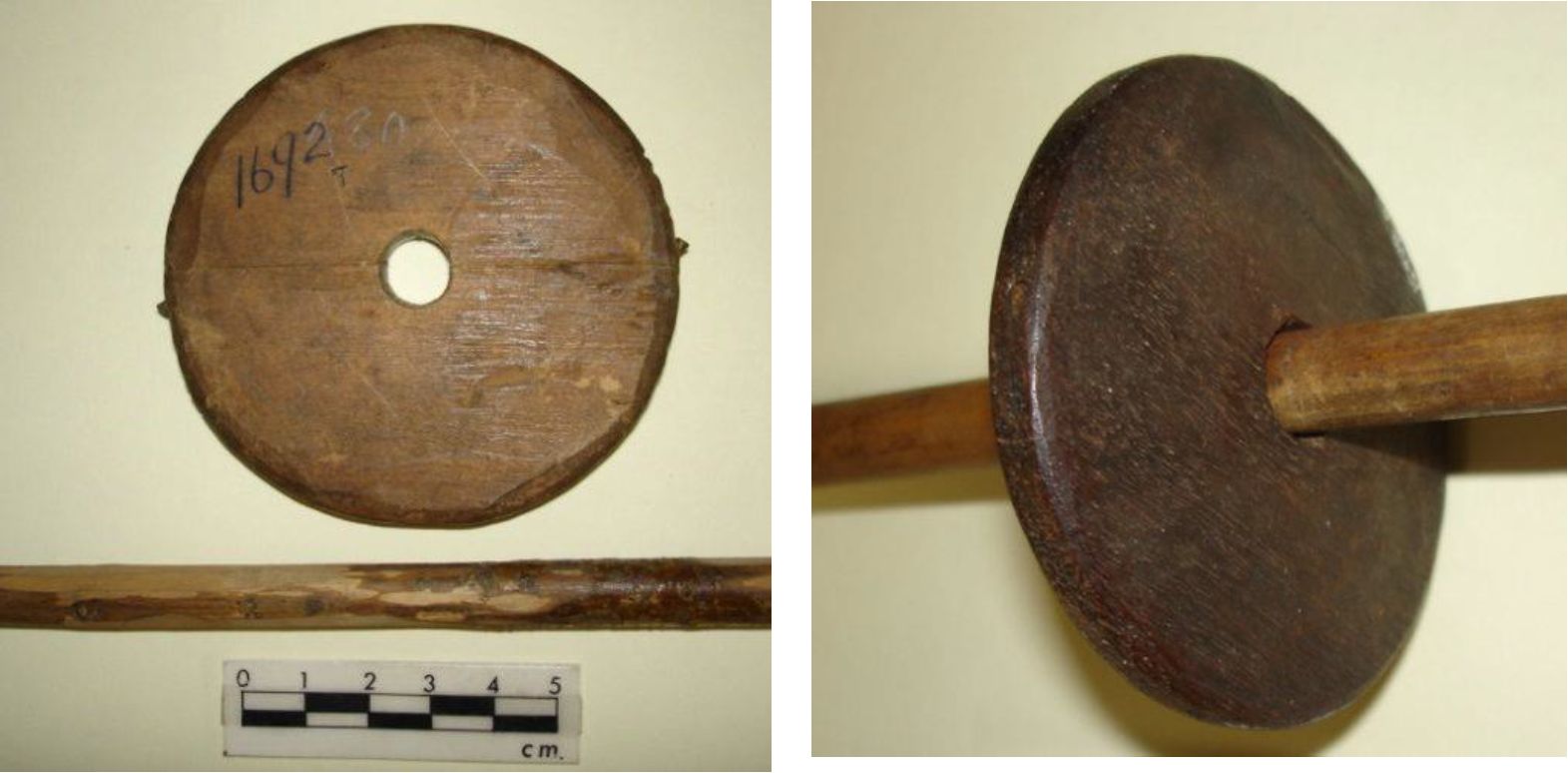
Haida
RBCM 9963a&b. (with spindle) (old #963). Bone. Near flat disc. Slightly concave on both sides. Weight: 45.9 grams. Diameter: 83 by 84mm; hole diameter 13mm.
Thickness: 4mm on outer rim to 7mm near inner hole. Spindle, wood. Length: 430mm. Thickness: maximum 13mm. Collected by Charles Newcombe in Masset, Oct. 1, 1913. (Newcombe Family papers. Add. Mss. 1077. Vol. 40, Folder 7. Subject Files, Series B: Collections. Photo by Newcombe, Nov. 1917, EC575 glass plate). Collected in 1913. From estate of William Newcombe 1961.
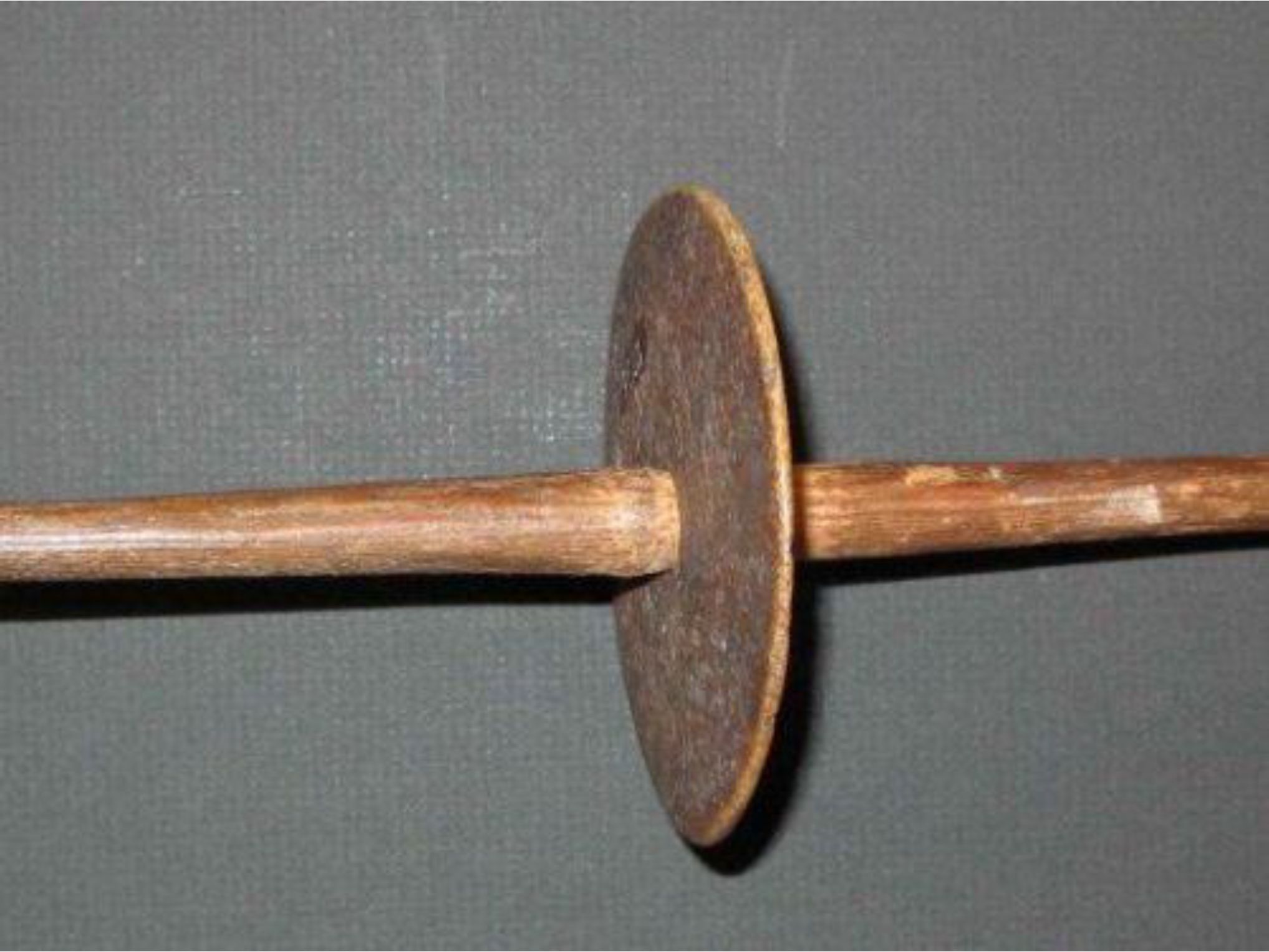
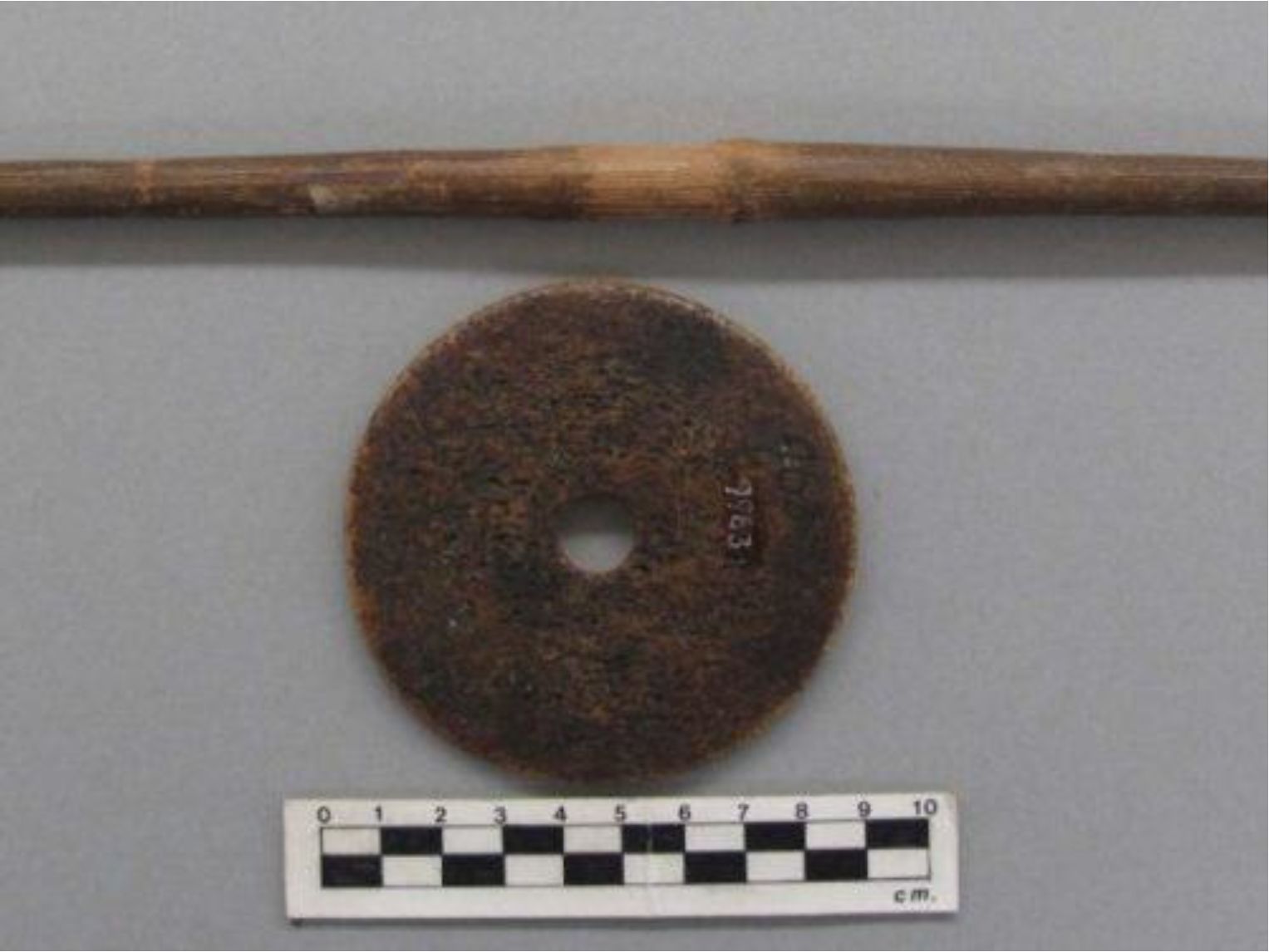

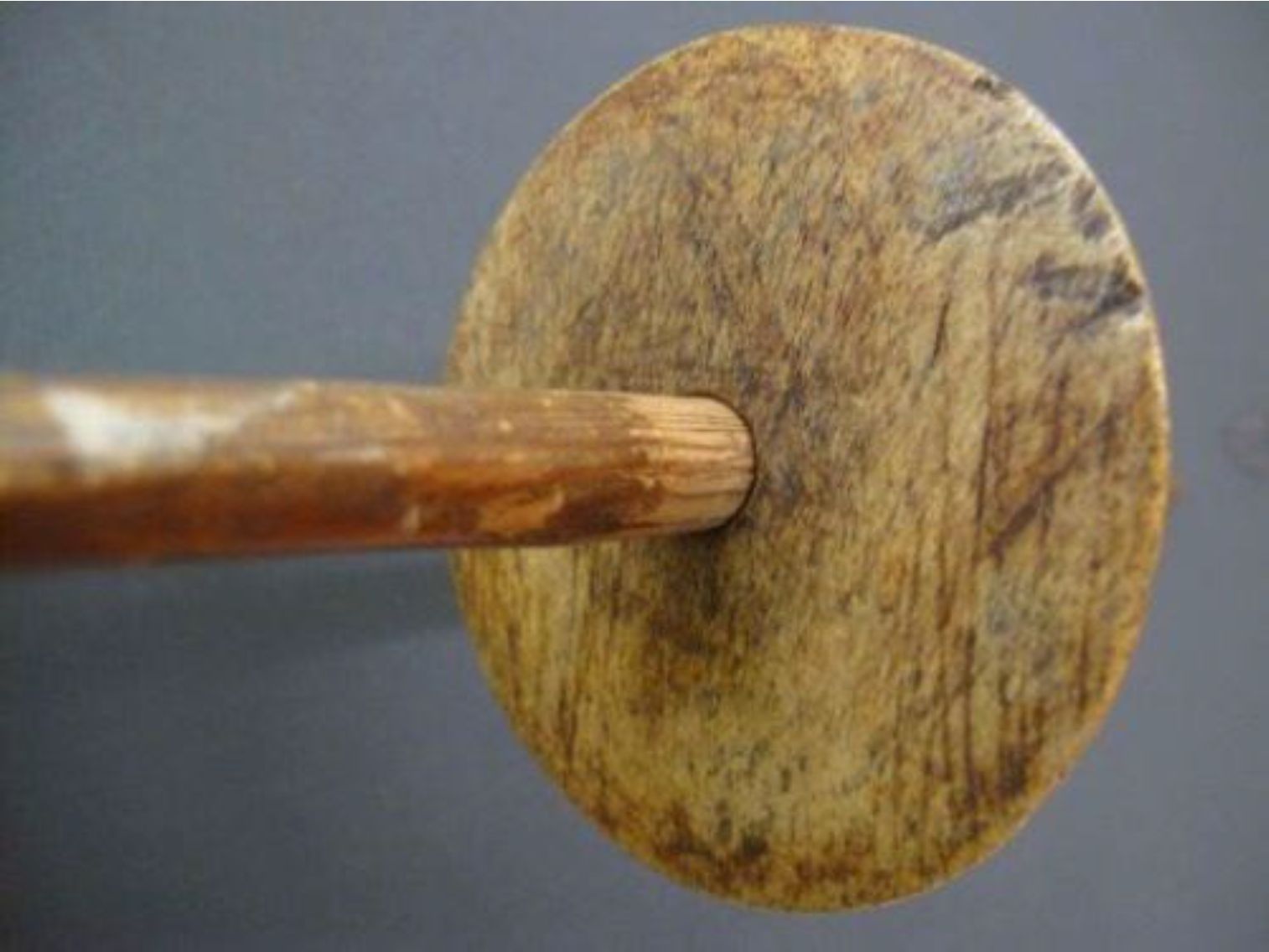
Haisla
RBCM 2066a,b. (with spindle); “Kitimat”. Wooden whorl. Maple? Diameter: 88.2X94.4mm; pencil line circle inside 73X77mm; th. 11.8X16.5mm (thicker near middle), whorl centered toward one end on spindle; hole dia. 11mm (slight burned area in hole). Edges flat and roughly carved. Spindle of Cedar. Length: 530mm; Thickness: 112.5mm. Weight: 64 grams. Whorl located 18cm from one end and fixed on spindle. Weight of spindle and whorl: 64 grams. Collected by Charles F.
Newcombe in 1911 from Mrs Robinson of Kitamaat.
RBCM 2067a,b. (fixed on spindle) (KW) “Kitamaat”. Sea mamal bone. dia. 59.5mmX65mm; th. 80-89mm; hole dia. 12mm. Spindle of cedar: L: 523mm. Thickness: 13.5mm. Whorl 230mm from one end, near center. Combined weight of whorl and spindle: 57.8 grams. Charles F. Newcombe 1911.
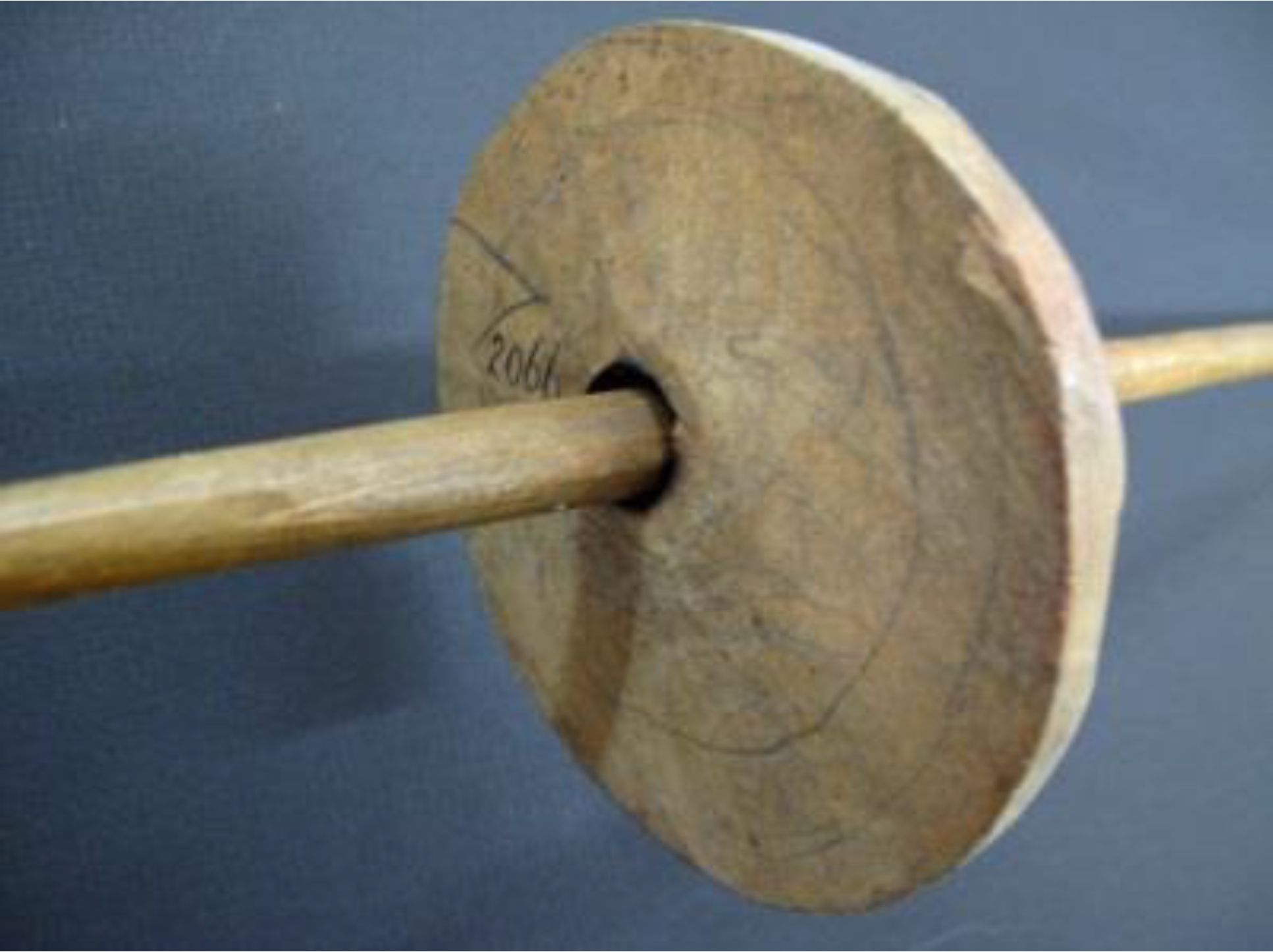
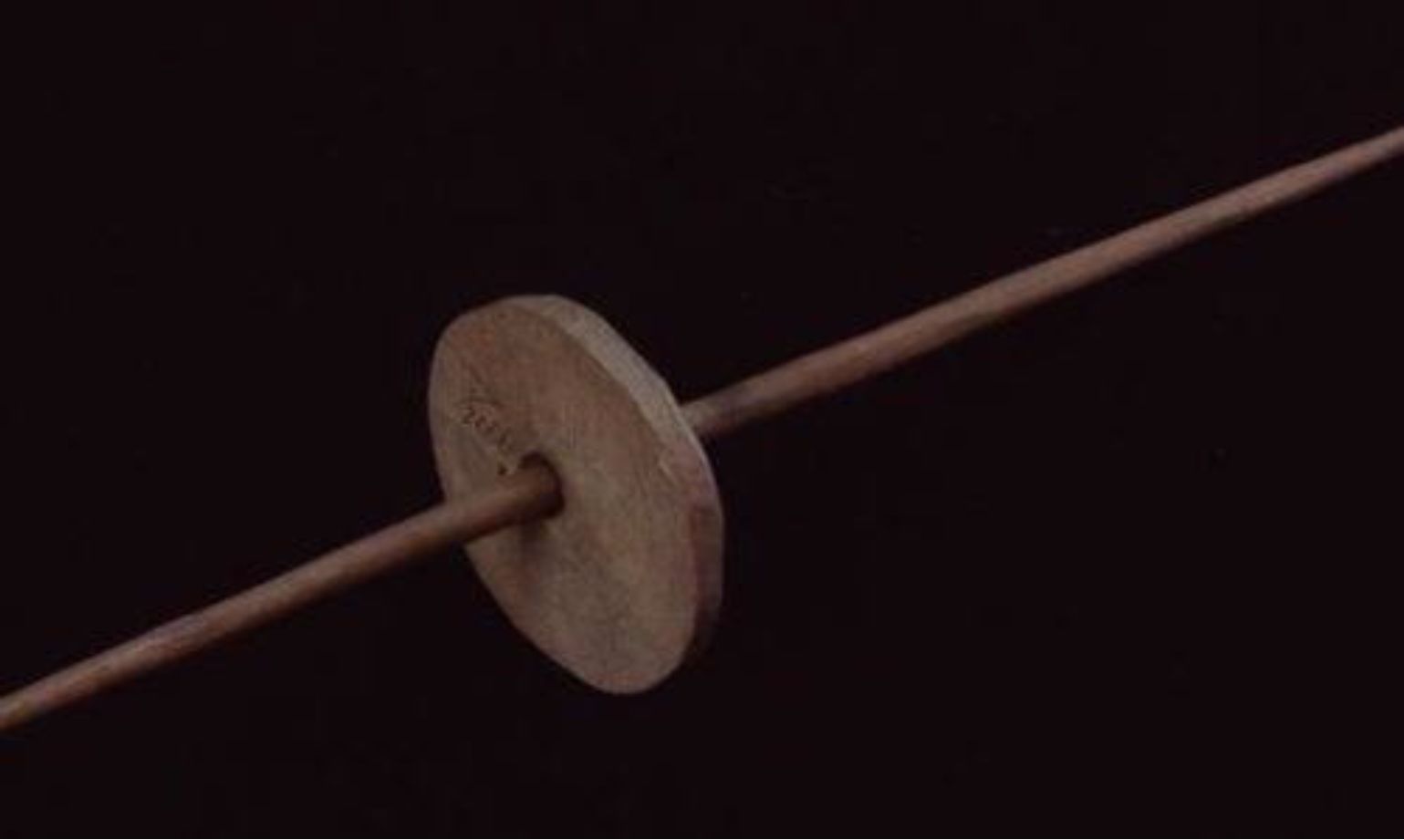
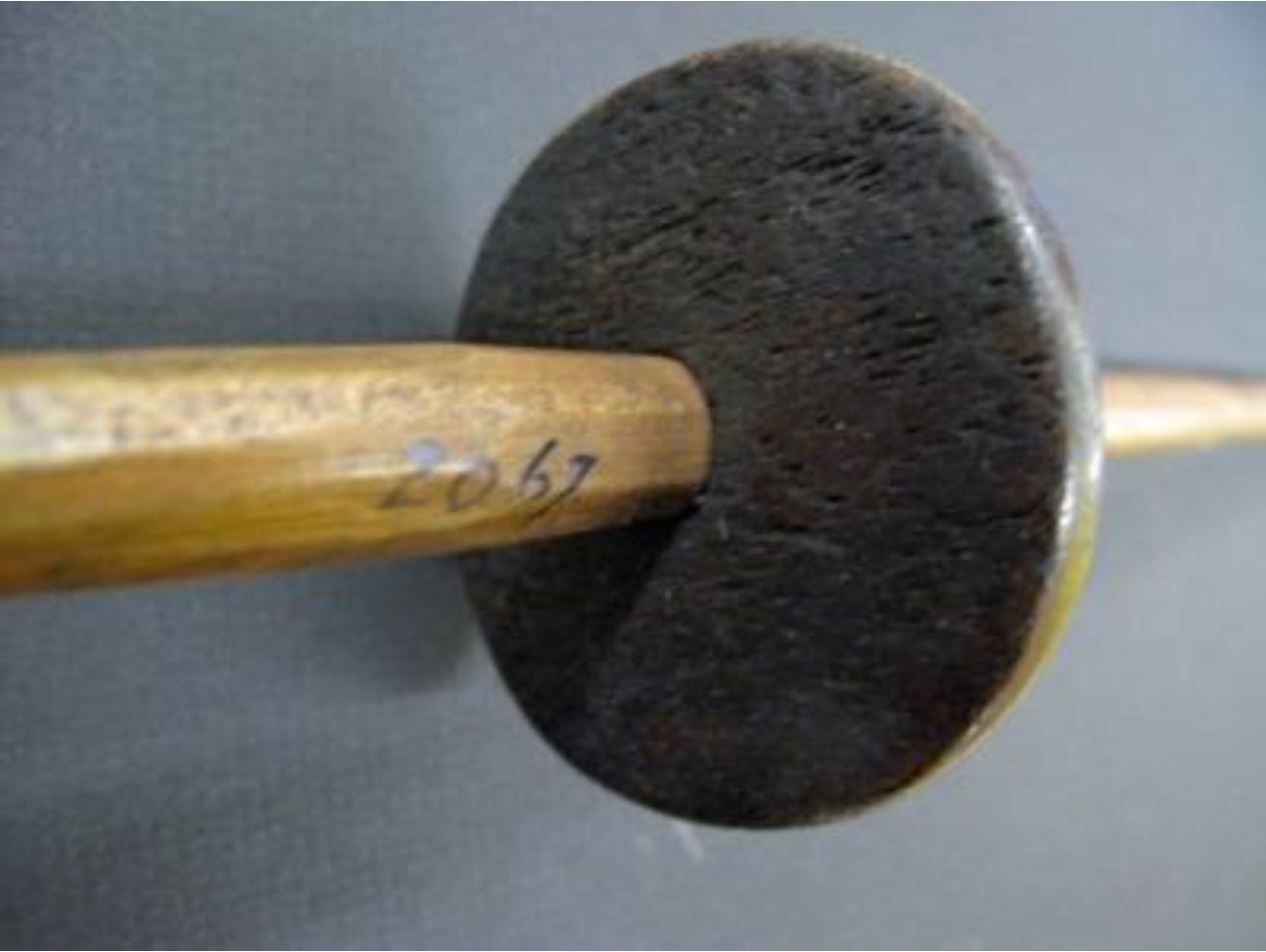
Heiltsuk (Bella Bella)
RBCM 449a & b – (with spindle) Bella Bella. Sea mammal bone. (1893, F. Jacobsen) diameter 62.7X65mm across hole. Broken. Whorl position off centre. th. 8mm; hole dia. 9mm. Whorl fixed on cedar spindle, combined weight 49.8 grams. Spindle L: 32.4 (small portion of end broken); Width: 8.6mm. Preliminary Catalogue 1898: “Wooden spindle, with bone whorl and native wool”.
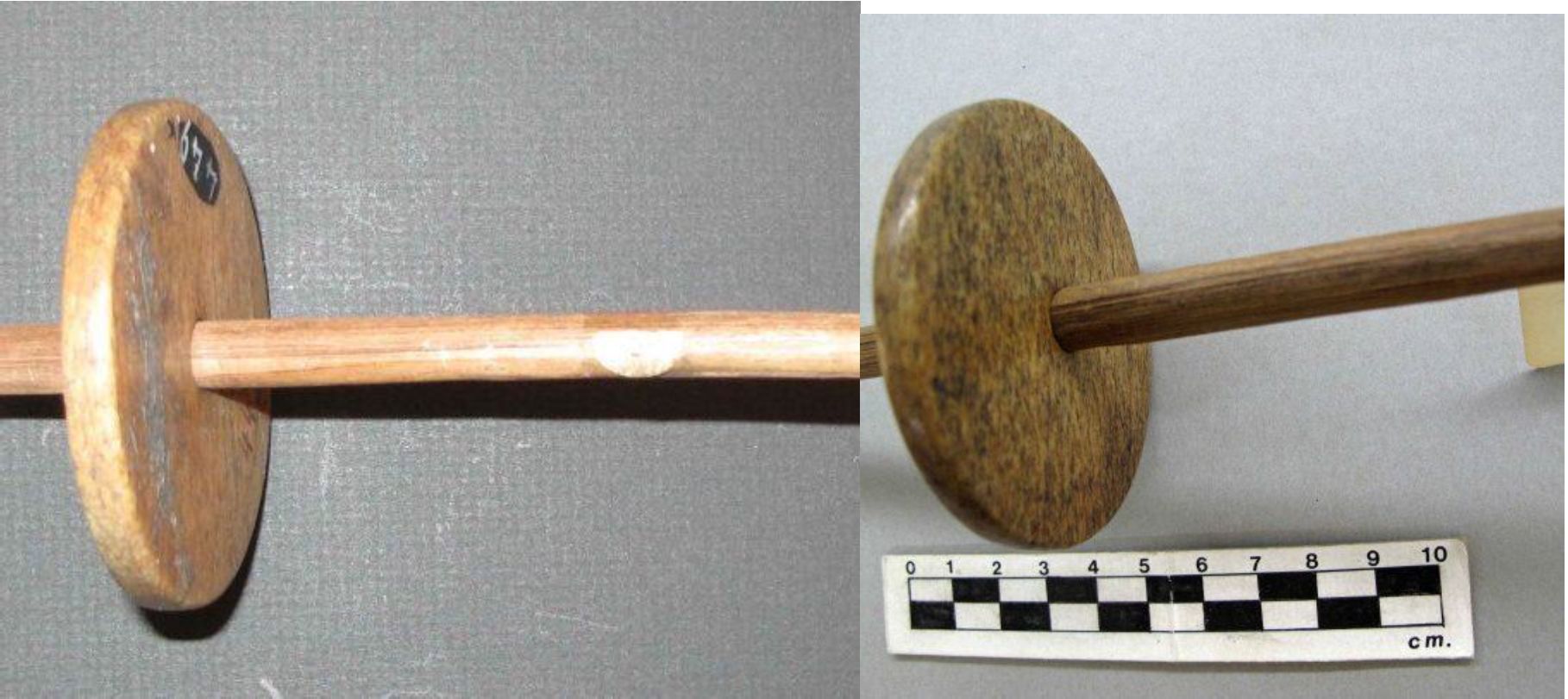
RBCM 450a & b – (with spindle) Bella Bella. (1893, F. Jacobsen); Sea mammal bone. Flat body and edge. dia 71-77mm; th. 8.3-8.8mm; hole dia. 11mm; Spindle L: 550mm; Th: 10.3mm. Whorl fixed on spindle. Combined weight: 62.3 grams. [Recorded in 1898 catalogue, p. 164]
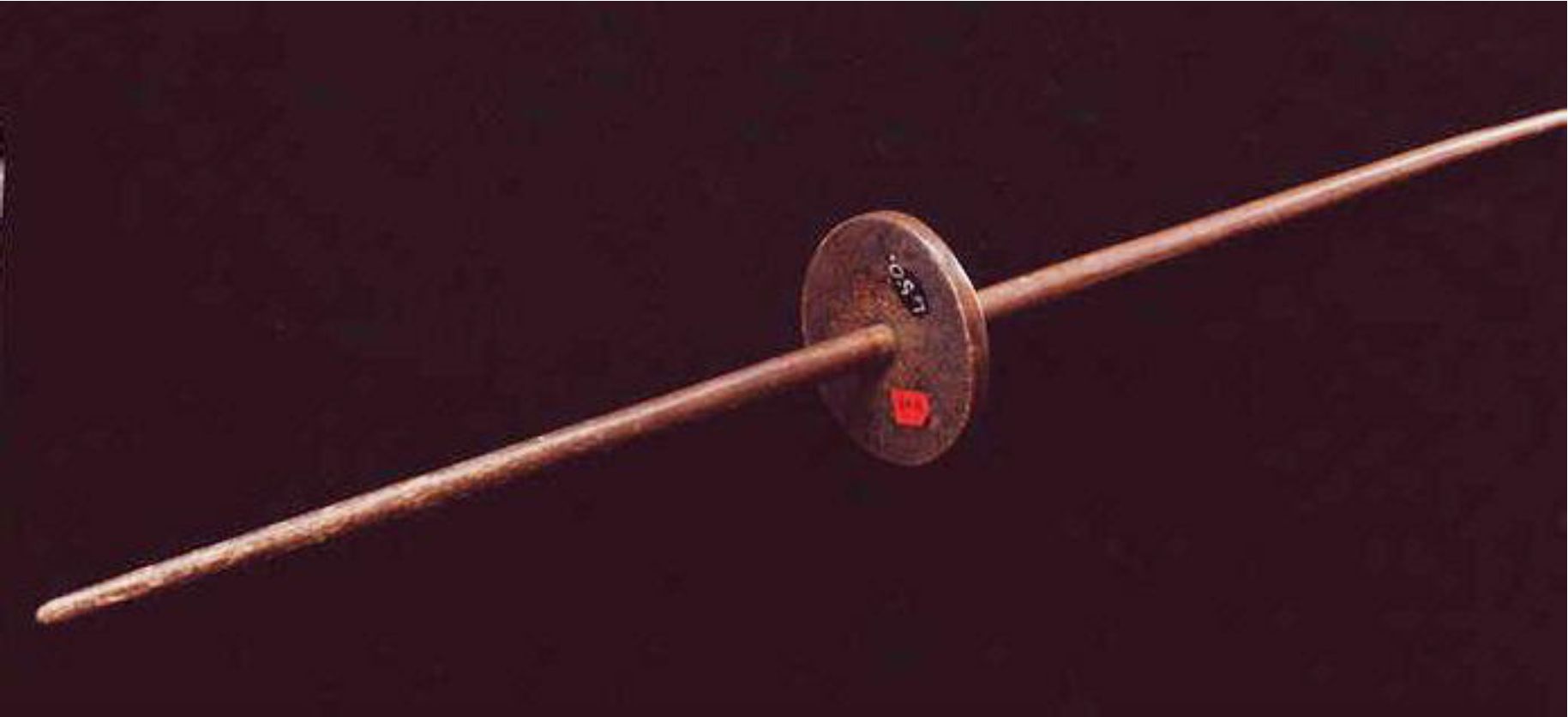

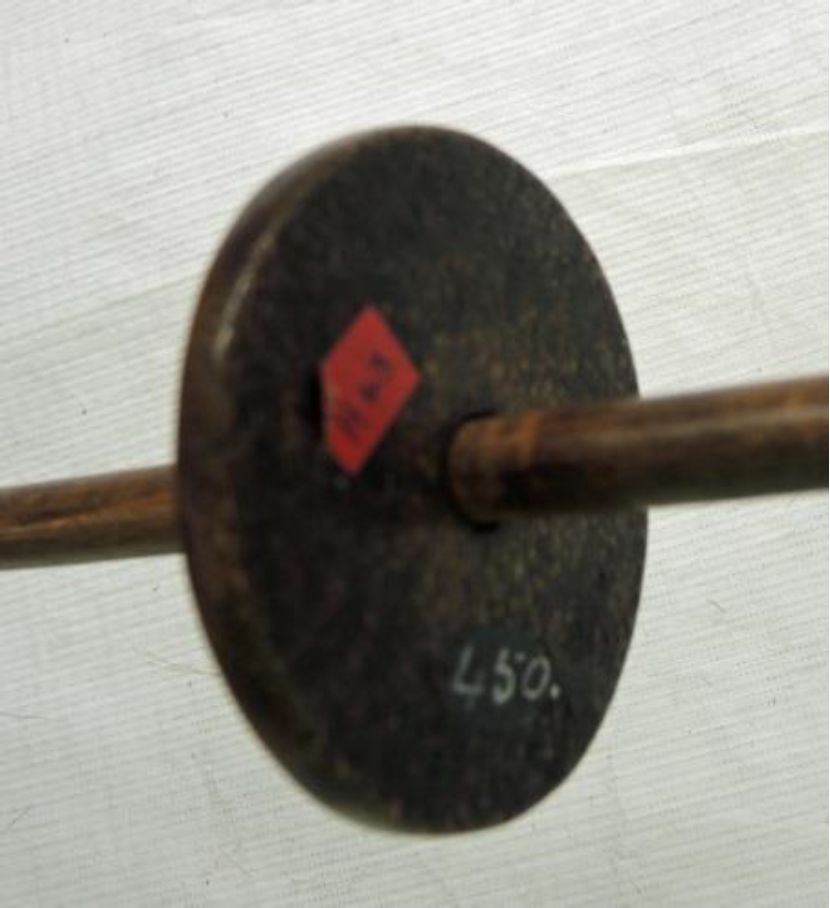
RBCM 451 (with spindle). Bella Bella. (1893, F. Jacobsen); sea mammal bone. Flat whorl; Edges flat with rounded corners; dia. 60X63mm; th. 5.9 – 6.4mm; hole dia. 11mm. Spindle: L 545mm; Th: 11.2. Whorl centered at 280mm. Combined weight of whorl and spindle 51.8 grams.
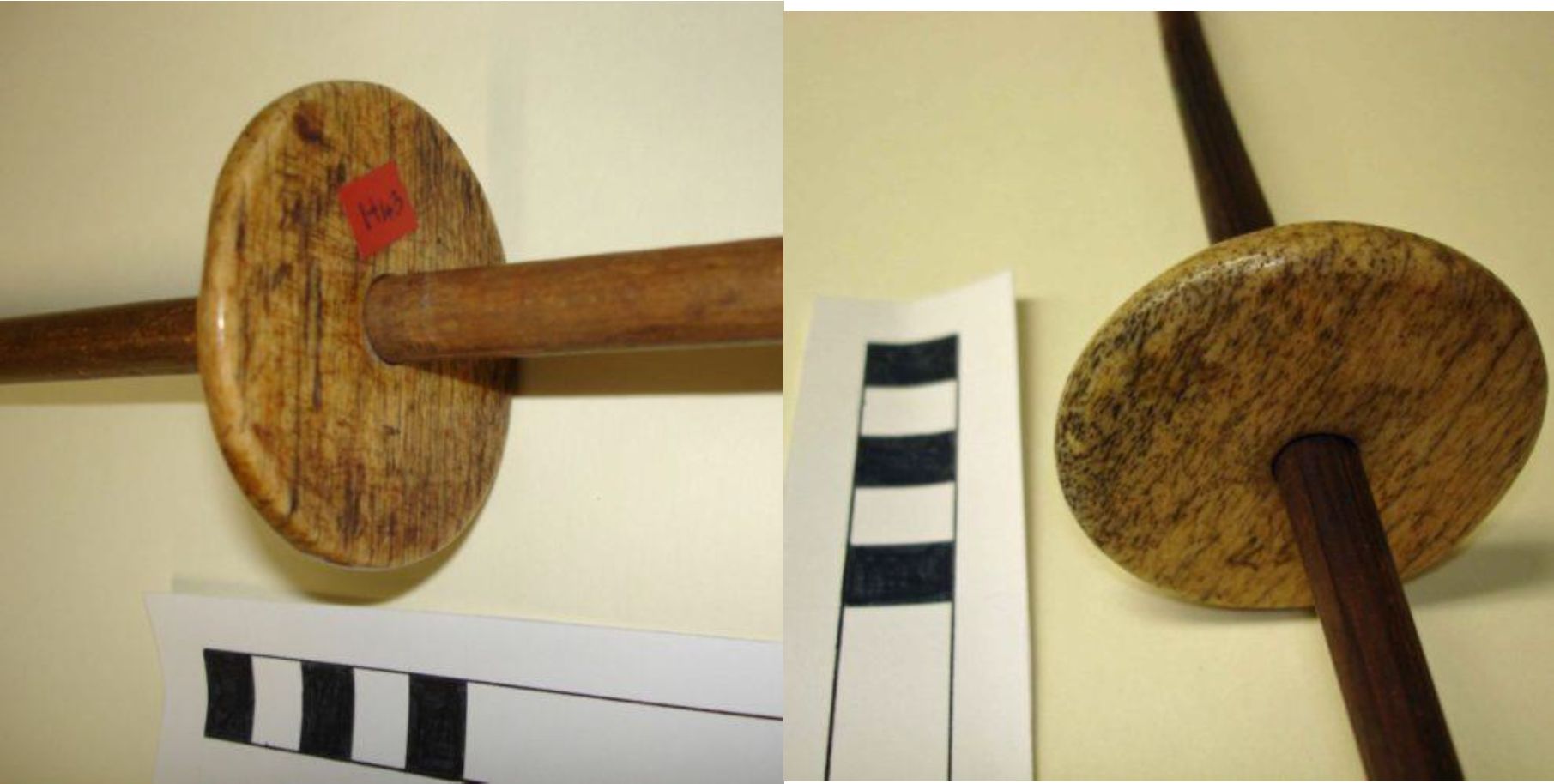
RBCM 452a & b. – (fixed on spindle). Bella Bella. Sea mammal bone; dia. 58.8X59mm; th. 95mm; hole 11mm. Cedar Spindle: L: 410mm; Th: 10mm. Whorl 160mm from one end. Combined weight of whorl and Spindle: 48.9 grams. Whorl fixed on spindle. Collected in1893 by F. Jacobsen.
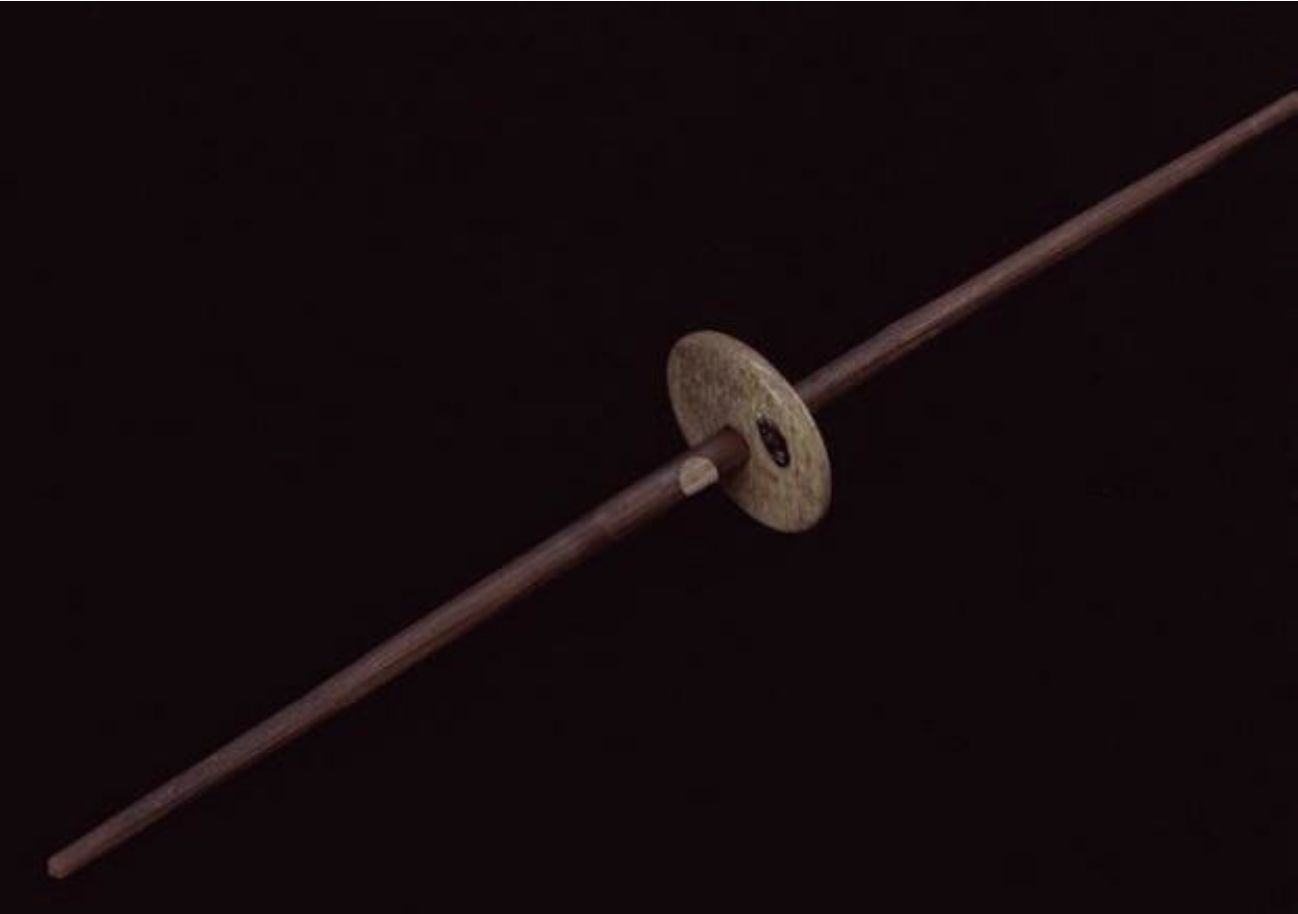
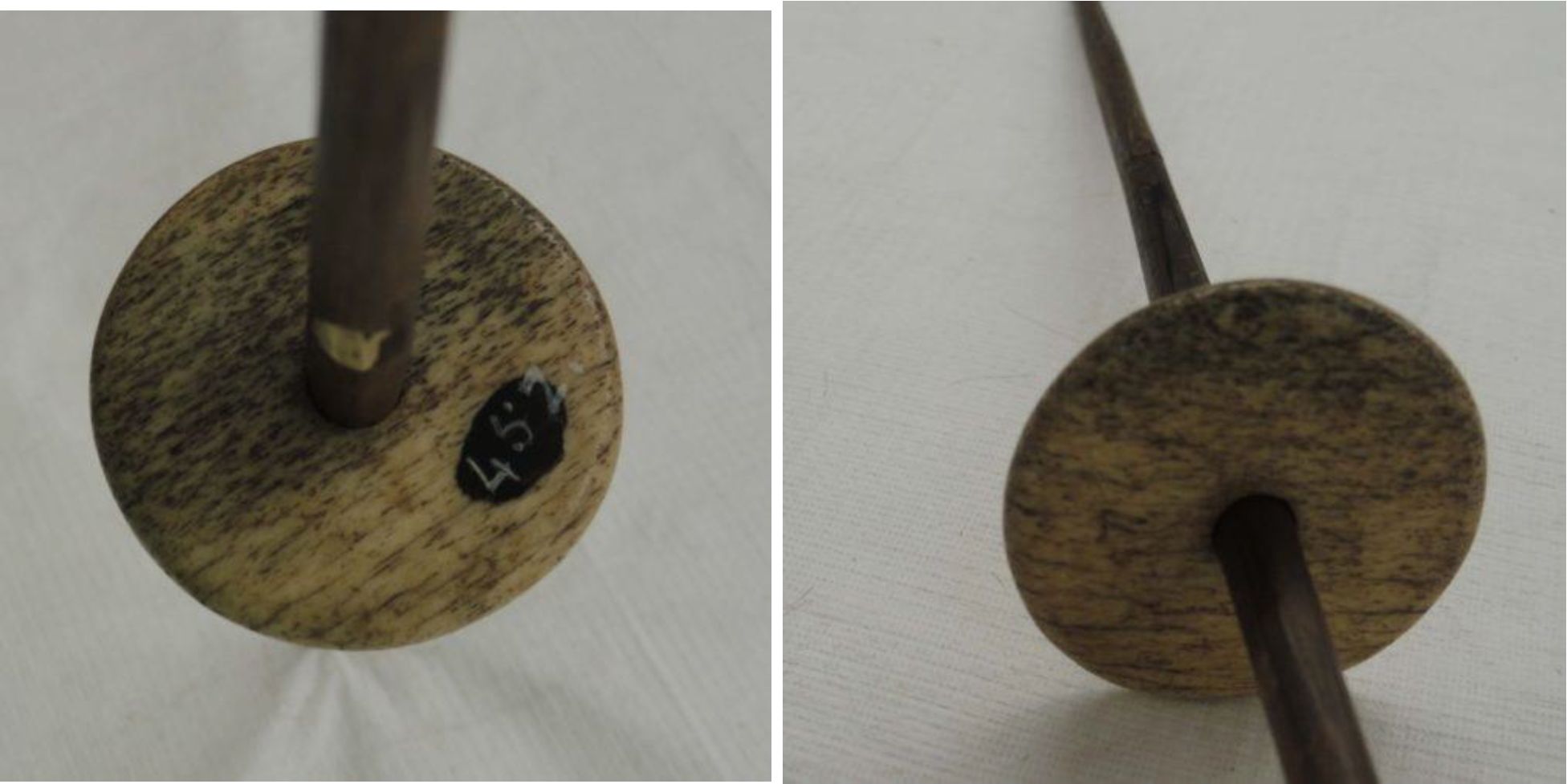
RBCM 454 – Listed in Old Catalogue as “Kwakuitl”. “Carved bone whorl. “Frog on one side, mountain spirit on other”. “A. Jacobsen 1893, Bella Bella.” Acquired April 1909. The 1909, Guide to Anthropology Collection in the Provincial Museum repeats this information on page 37: “No. 454 has a frog on one side and a mountain spirit on the other”. The label of Newcombe’s Lantern Slide, EC374, has “Bella Bella Spindle whorl” on it. This artifact was stolen when on loan for an exhibit in Vancouver in 1936. A poor quality caste is located in the archaeology collection as Y-806 (75-7). The connection with this and #454 had been lost until now. The cast is nearly flat: Diameter: 67-68mm. Thick: 7.0mm at center and 6.5mm at the edges. Hole diameter: 10mm. Black and white photograph #22603. The “mountain spirit” has a human-like face with round eyes, heavy eye brows and raised cheeks. Newcombe EC374 “glass plate”, 1909 – copied as pN 1337 – shows the same image. Photograph 721 shows the frog design from Newcombe’s 374-IX/69, 1909, and a different version of the same frog image in photograph 721-A – listed as EC 374 – IX/69, 1909.
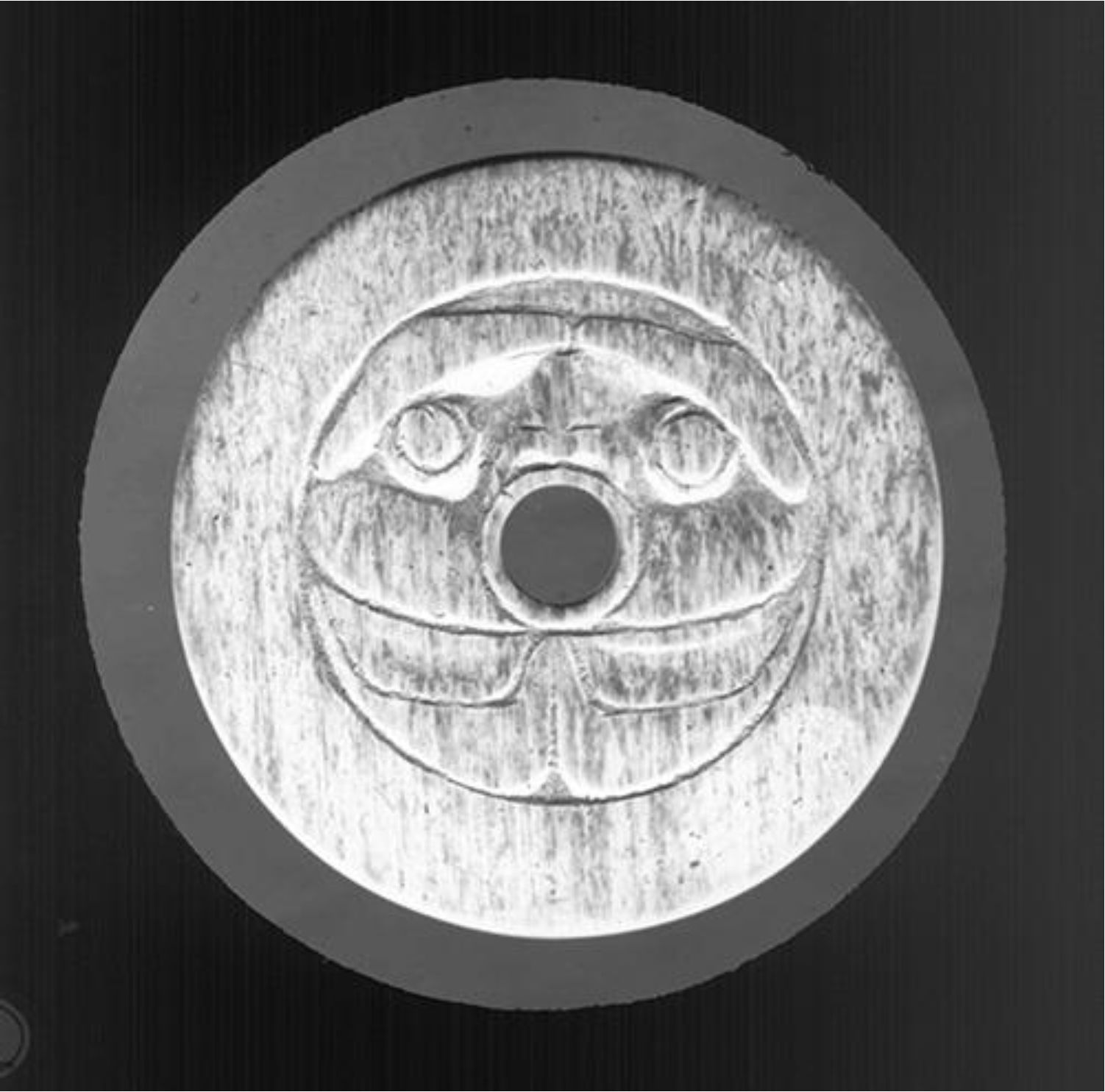
Nuxalk (Bella Coola)
RBCM 2978 – (fixed to spindle) Bella Coola. Wooden whorl. Dia. 76X82mm; Th. 1219mm (thickens toward middle); hole 10mm; Hardwood Spindle. L: 440mm; Th:
10mm. Whorl near middle of spindle. Combined weight of spindle & whorl: 59.5 grams. (purchased from Capt. Schooner, 1917); (in image PN11455).

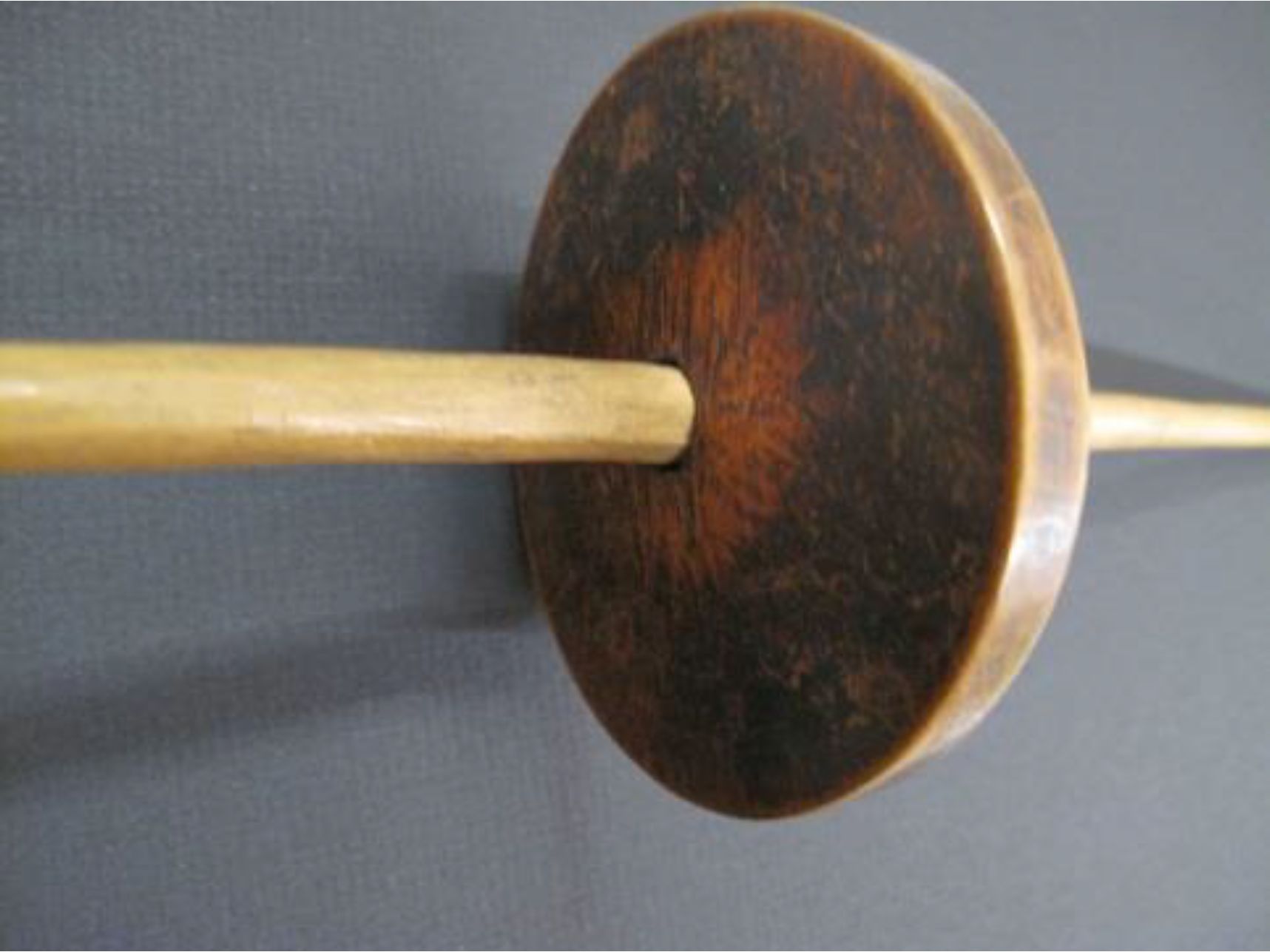
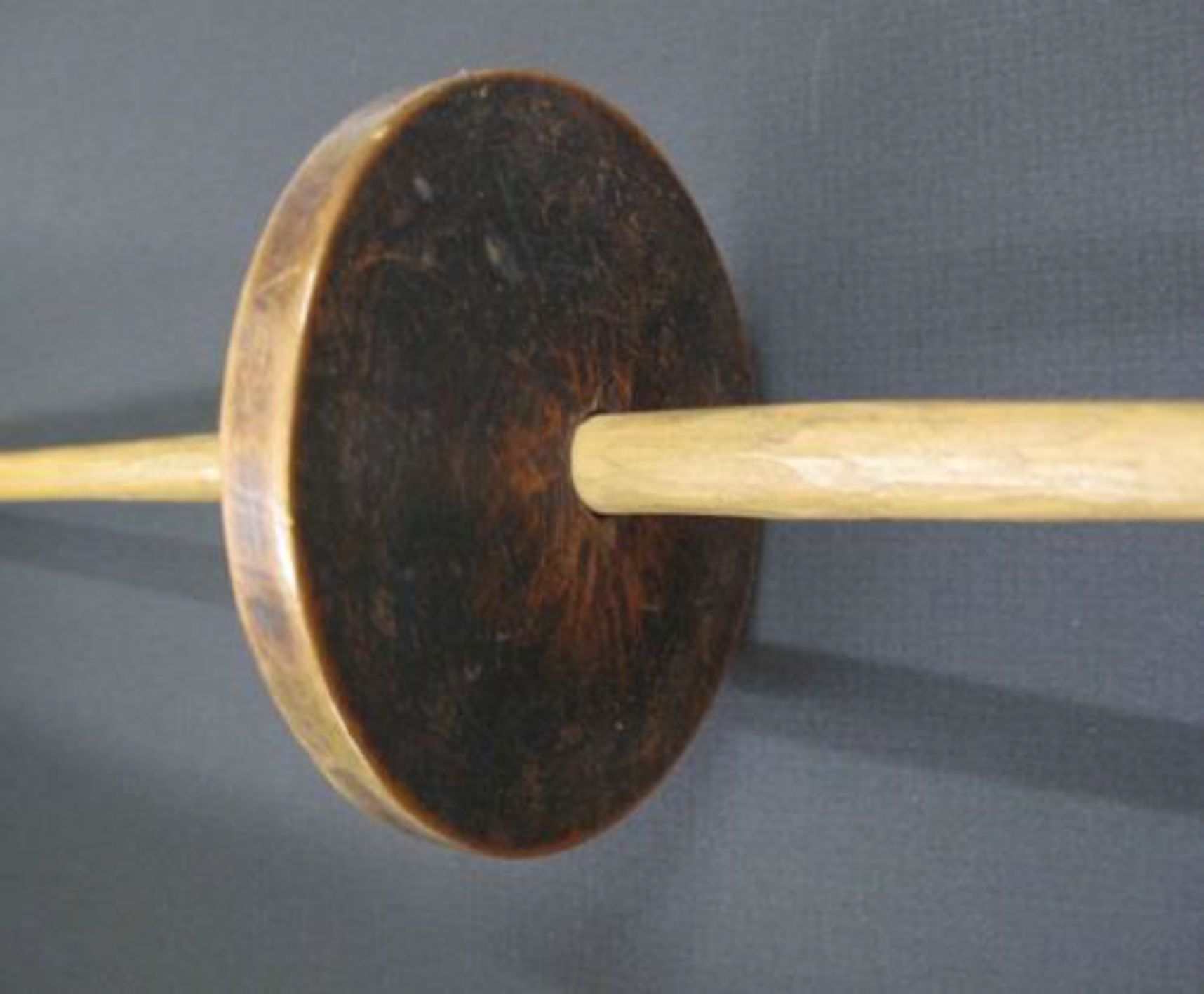
RBCM 9986 – (moveable on spindle); Bella Coola; sea mammal bone, flat. Dia. 66X68mm; th. 12-14.5mm; hole 10mmm; Flat edge with 3mm inset low area; Weight: 26.5 grams. [1914, ex Gibson coll. “Bought at Van. Canadian Handicraft Guild 6/8/14”, then into Newco mbe collection; old # 986]. Spindle: L. c400mm; Whorl positioned mid-way, c, 200-210. Spindle weight: 16.2 grams. Old #986. Pencilled at center of spindle: “Spindle Ex… Gibson. 1914”.

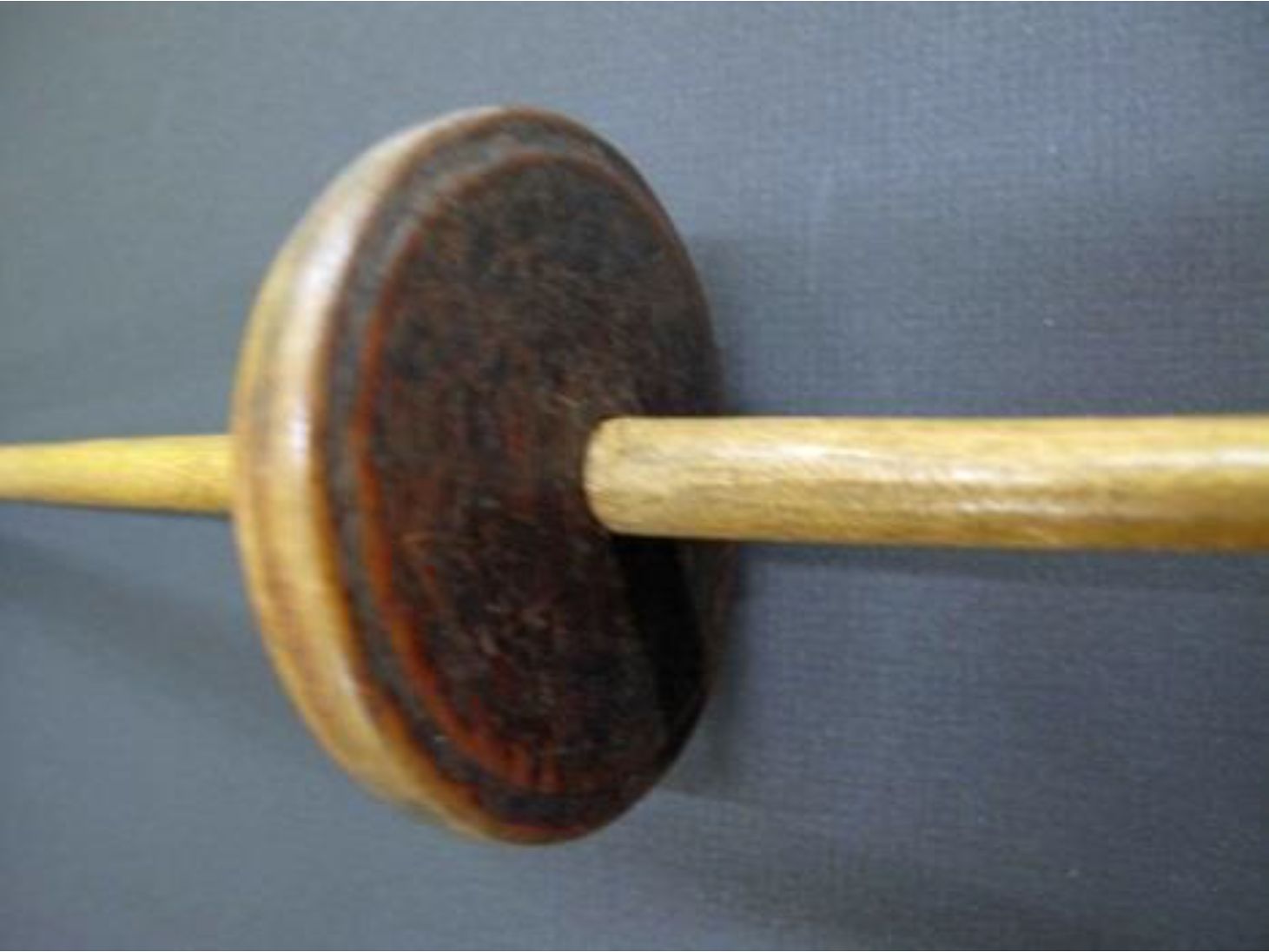

RBCM 10112 – (fixed on spindle) Nuxalk; Flat, sea mammal bone. Dia. 49-51mm (squarish); th. 11.0-12mm; hole dia. 9mm. “Bella Coola” in ink on one side. Old # 1112. Cedar spindle. L: 515mm; Th: 9mm. Positioned between 260mm and 270mm on spindle. Combined weight of spindle and whorl: 43.0 grams. Newcombe, June 1917. Newcombe photo EC575. Nov. 1917.

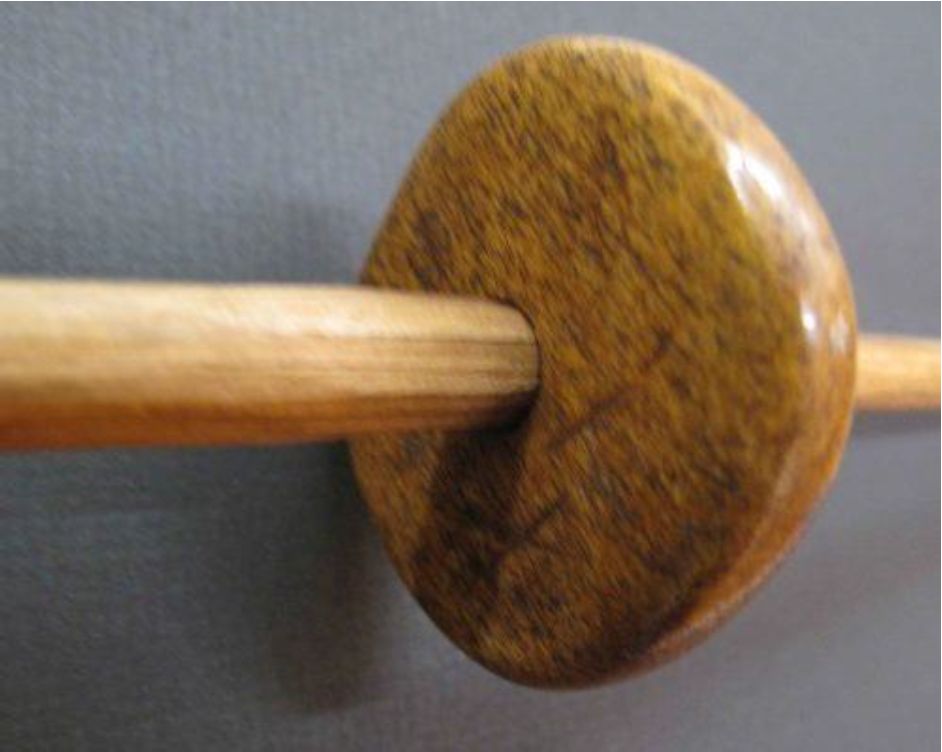
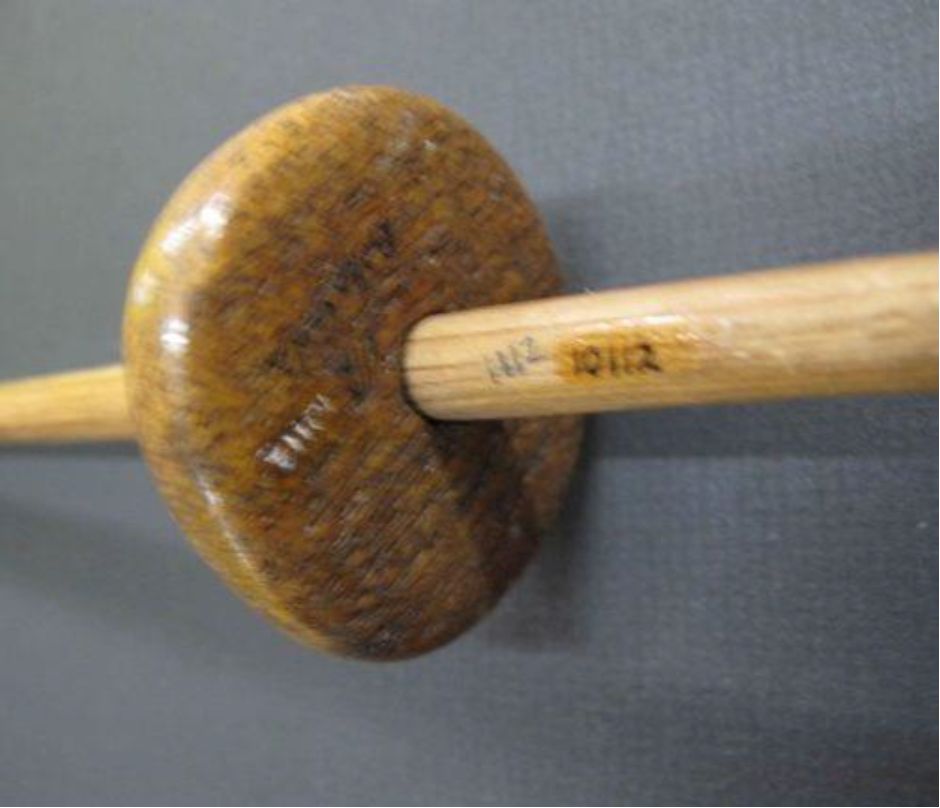
RBCM 10113 – (no spindle) Bella Coola; Flat sea mammal bone. Flat edge with rounded corners. Weight: 33.8 grams; dia. 65-65.9mm; th. 6.5; hole dia. 12mm; Slightly burnt.
Newcombe collection, old # 1113, glass plate photo, Nov. 1917, EC575.
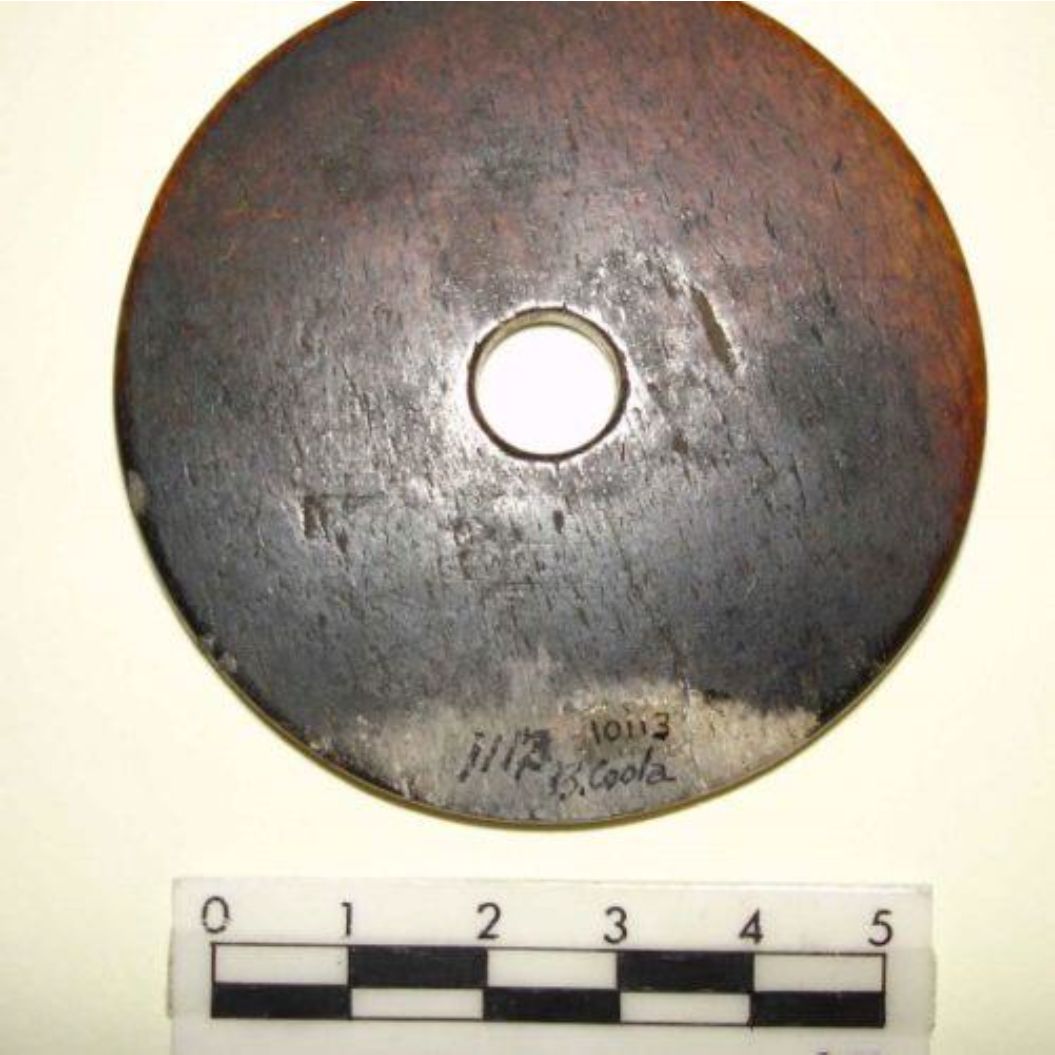
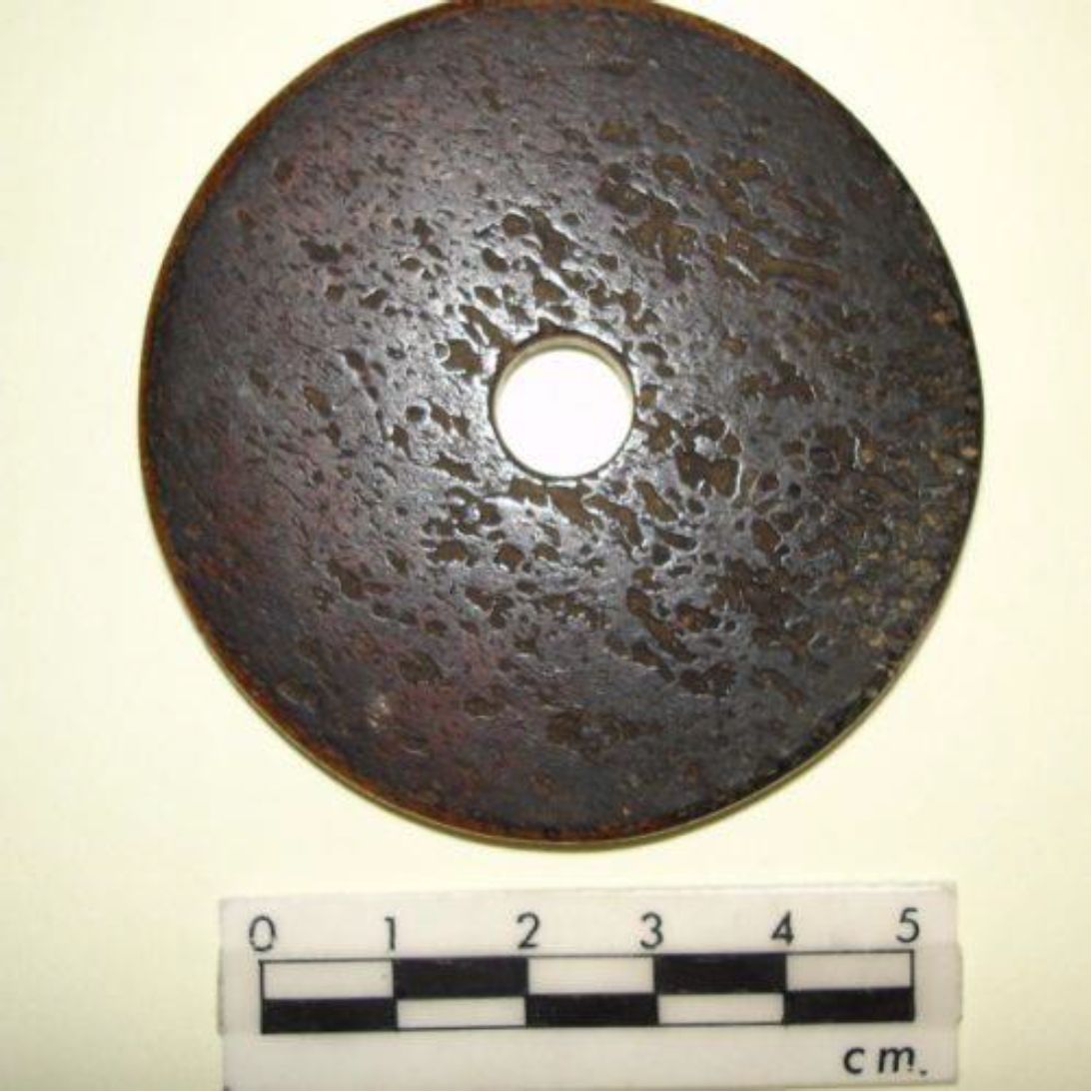
Kwakwala Speakers
RBCM 2068 – (no spindle); Alert Bay. Sea mammal bone. Weight: 71 grams; dia. 67.1X69mm; th. 14.1-14.4mm; hole dia. 13mm. (old C.F. Newcombe #359. Collected in 1912).
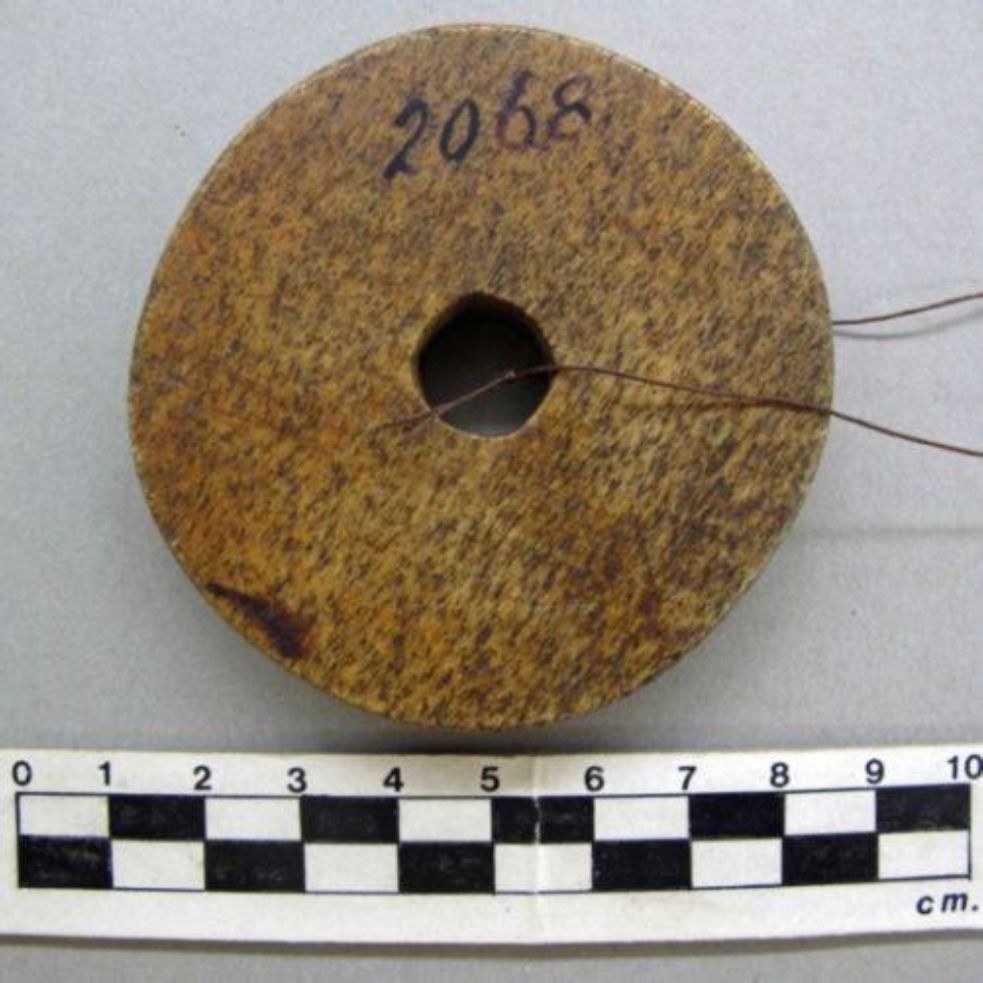
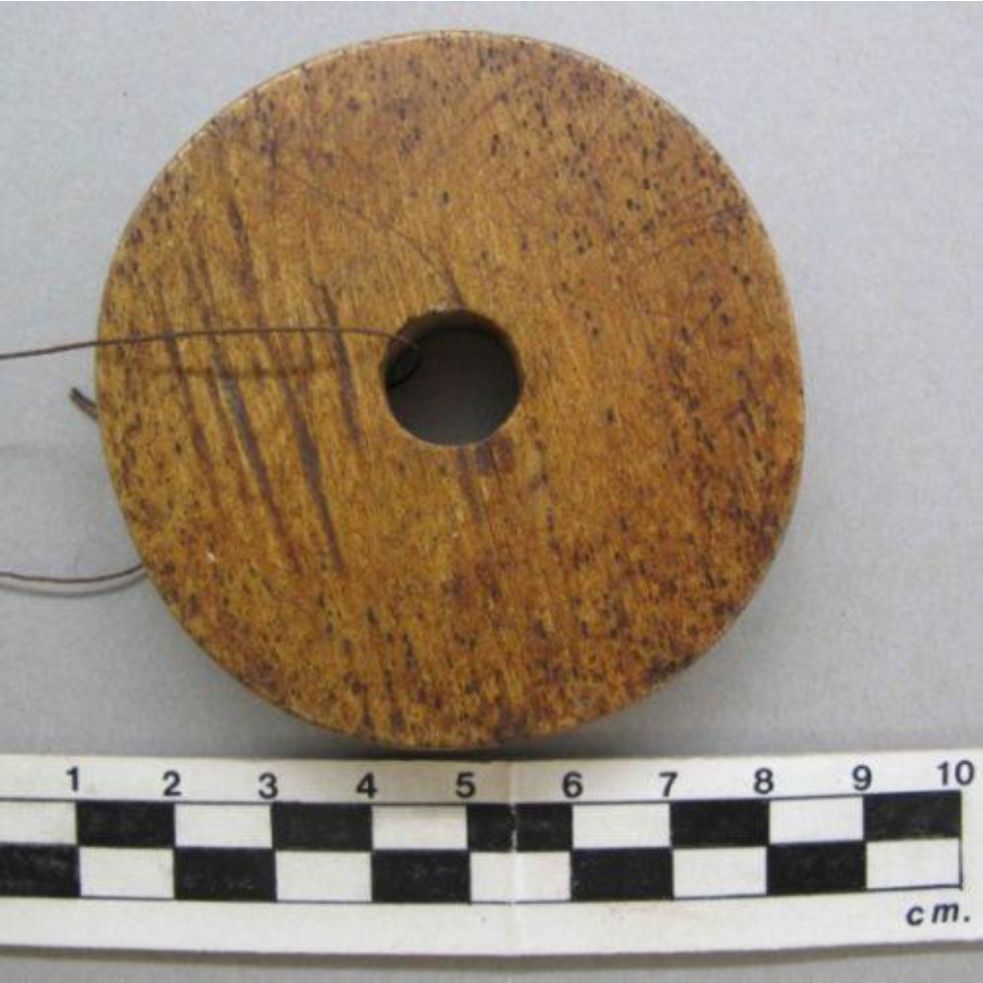
RBCM 2069 (no spindle); (KW); Sea mammal bone. Weight: 25.4 grams. dia 55mm; th. 6.67mm; hole dia. 11mm; (19-21mm radius shift from edge of hole). Flat with flat edges. (old C.F. Newcombe #360 collected in 1912).

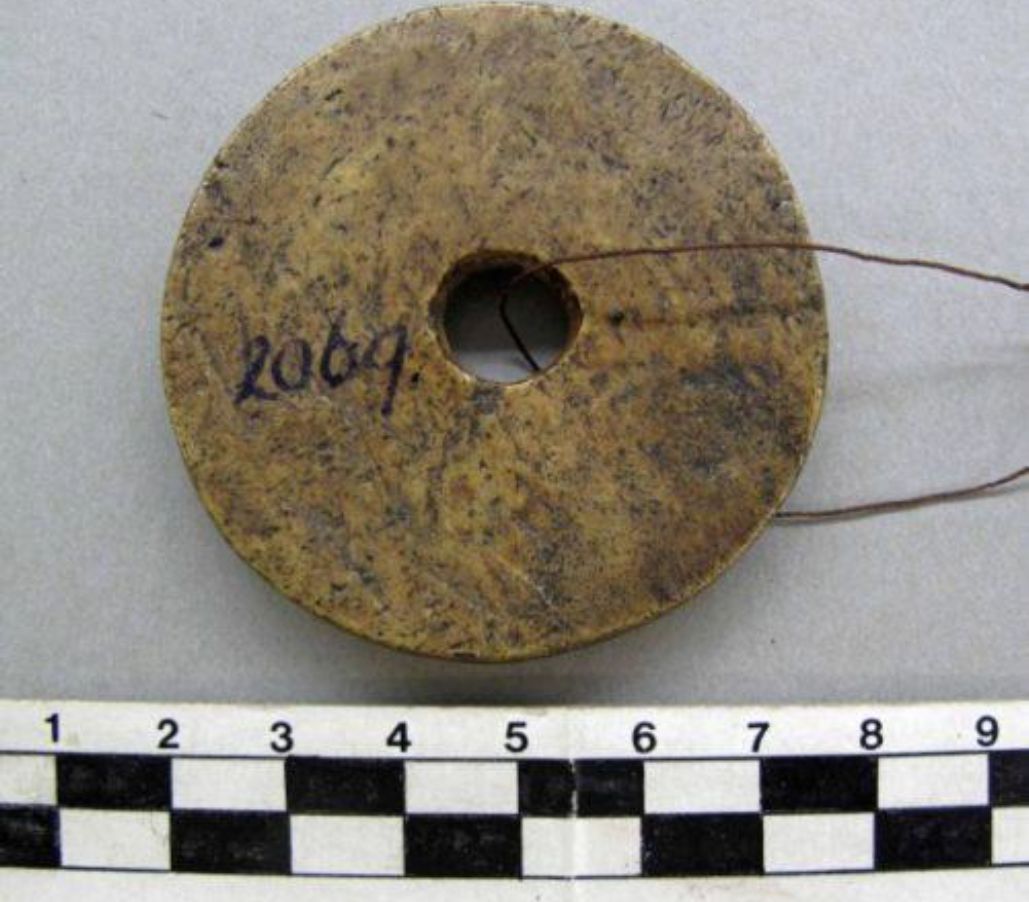
RBCM 2070 – (no spindle); Alert Bay; Sea mammal bone. Weight: 19.7
grams. Diameter: 47X48mm; th. 6.1-6.3mm; hole dia. 9mm; Flat with flat edges. (old C.F. Newcombe #361, collected in 1912).

RBCM 6530 – (with spindle) (KW); Sea mammal bone. Diameter: 58X62mm; th. 8X8.2mm; hole dia. 8mm. Combined whorl and spindle: 48 grams. Fixed Whorl, located 15cm from one end of spindle. Spindle: L. 406mm; Th: 8.2mm. Acquired 1947. “Spindle with whale bone whorl for nettle fibre plain”. “Canon A. J. Beanlands Coll. Per Mrs. Alyson N. Beanlands. Collected about 1884-1909”.

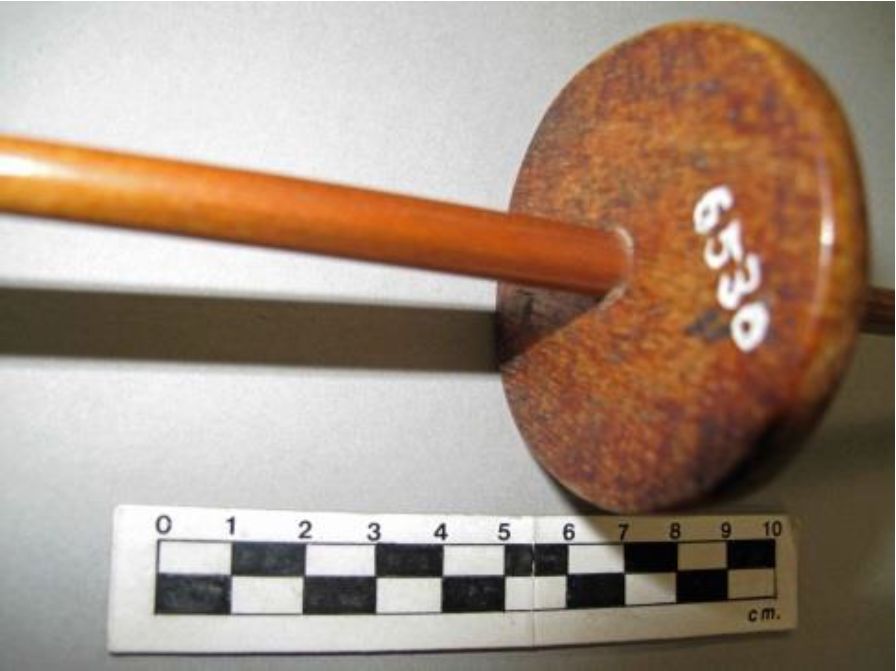

RBCM 10090a, b. (with spindle) (KW); Sea mammal bone. Diameter: 63.4X65.2mm; th. 6.16.6mm. Hole dia.: 11mm, Whorl weight: 8.9 grams. Slightly burnt by design. Cedar spindle. Whorl centered on Spindle. Spindle: L. 343mm; Th: 11mm. Kingcome Inlet. Old # 1090 written on center spindle under hole and on flat of whorl.
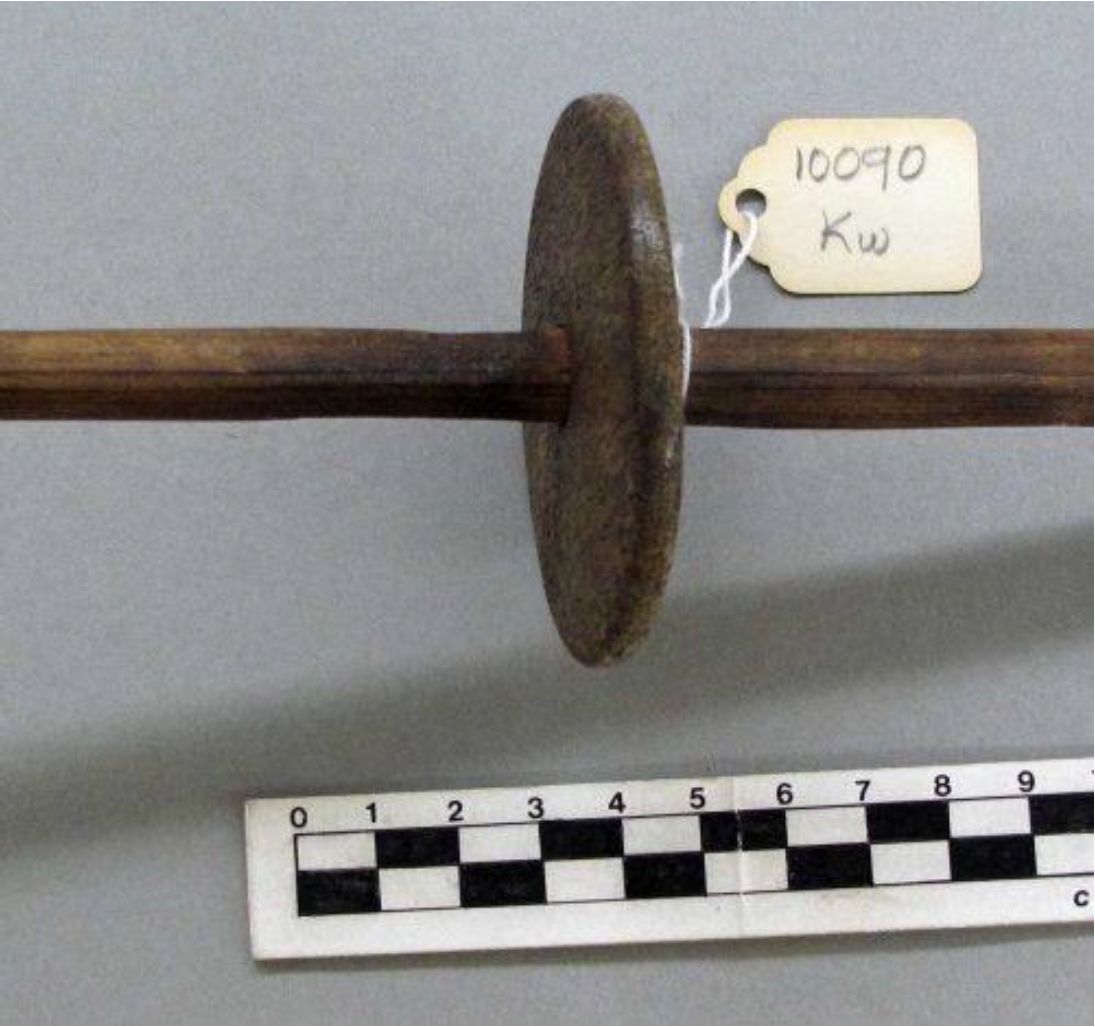
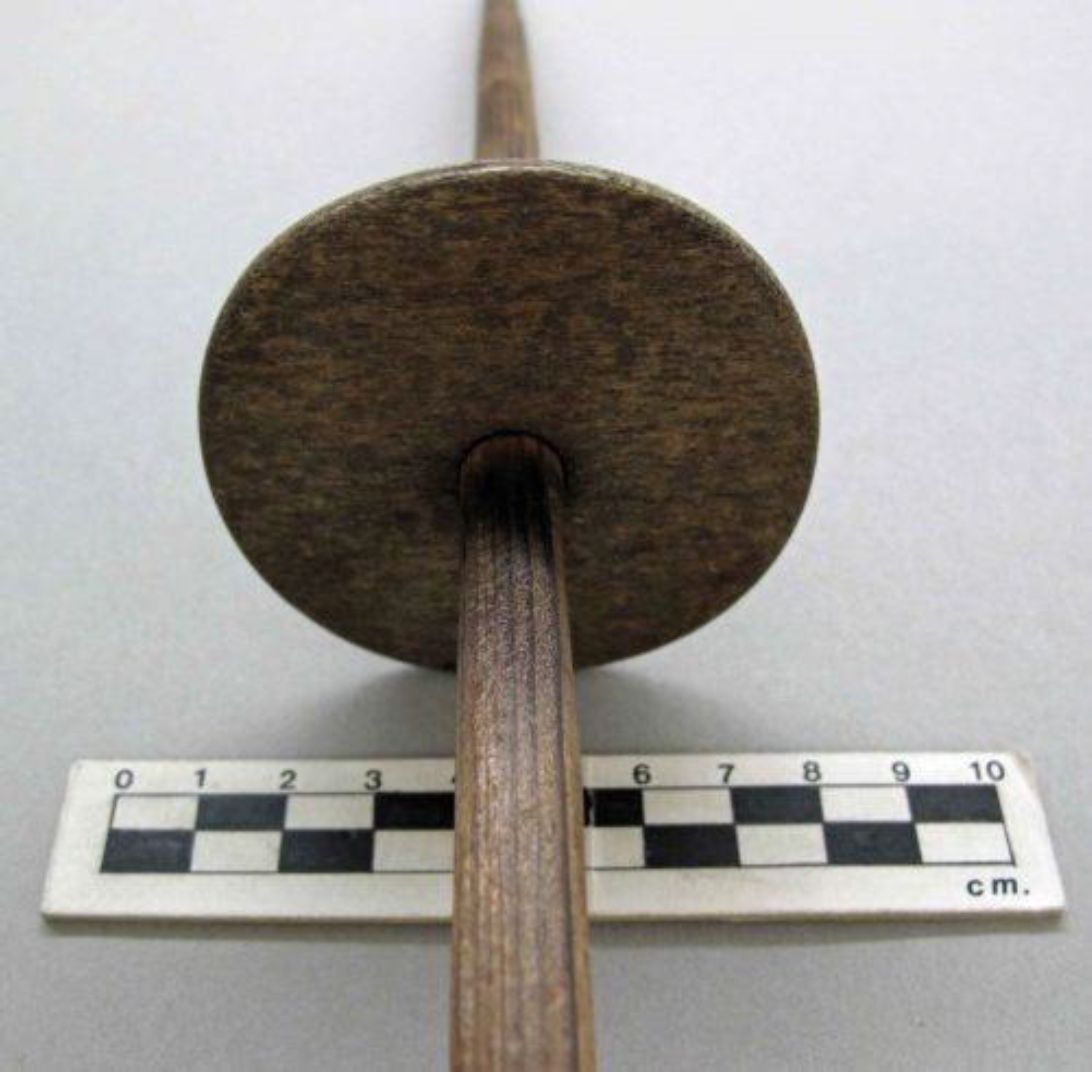
RBCM 10448 – (no spindle) “Fort Rupert, Tsaxis”. Sea mammal bone. Diameter: 59mmX61mm; th. 6-6.5mm; hole dia. 11mm. Weight: 22.9 grams. [old #1448].

Nuu-chan-nulth
RBCM 12691 – (no spindle); Quatsino. Grey Slate. dia. 72mmX73.8mm: th. 6.9-7mm; hole dia. 10mm. Painted red, green and black. Made with steel file. Two incised circle grooves on painted side. Whorl off center. Weight: 59.7 grams. No design on one side. Modern non-traditional whorl. It was likely made as a model for sale.
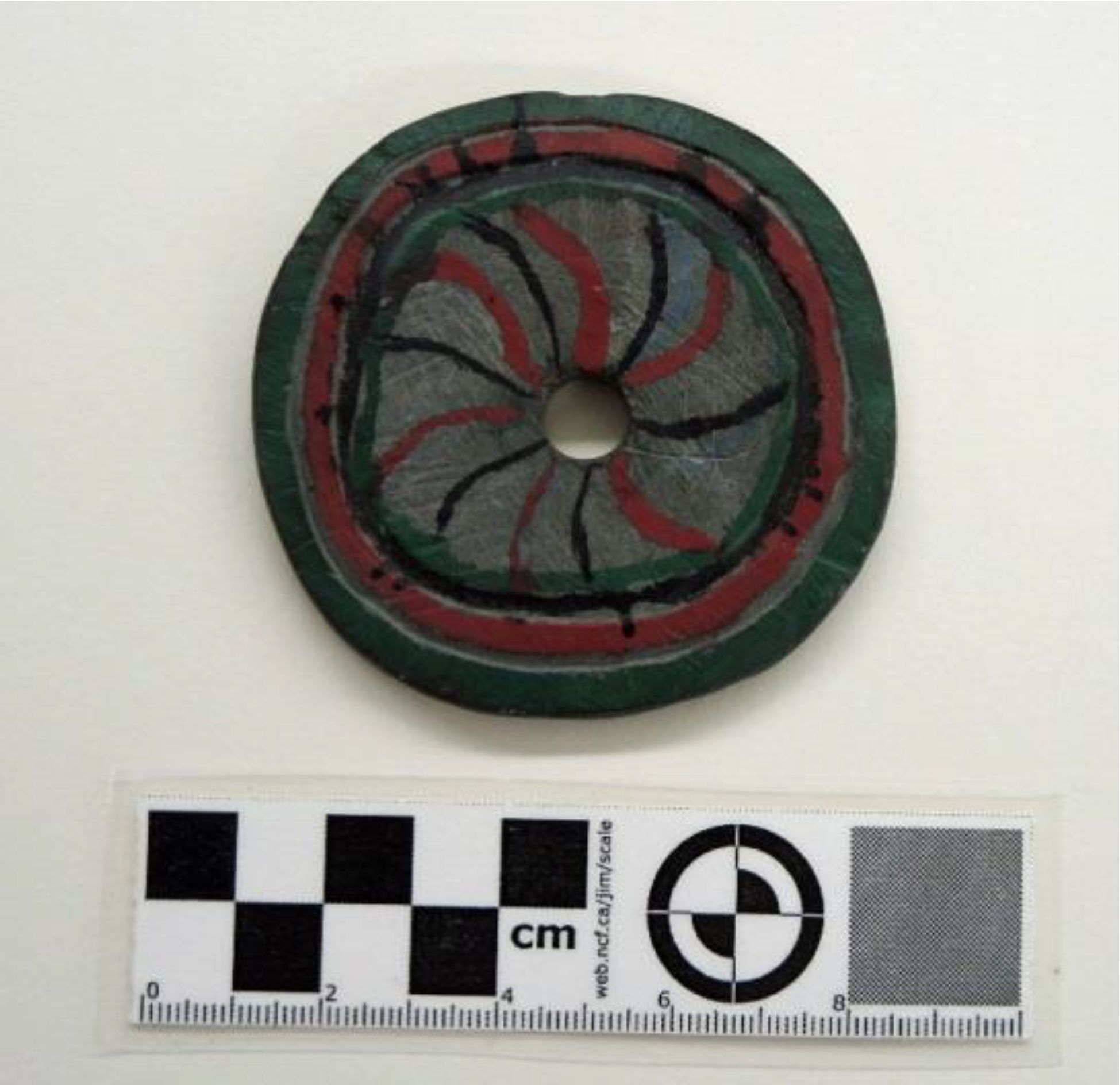
Comments on some Ethnographic and Historic Accounts
There are many references to spinning that can refer to spinning by twisting fibre by hand on the knee or references that do not specify the size of the spindle whorl. In a prospecting tour of the north coast James McKenzie notes that going up the Nass River he passed five villages during which he observed the spinning of “goat hair garments for women” without mentioning the use of a whorl (McKenzie 1864:3).
Morice observed in 1892-93 that: “rabbit skin blankets were originally the only genuine textile fabric manufactured among “the Carriers, the Tsekehne or the Tsilkohtin”. Strips of rabbit skin were tied together and twisted on the thigh, and used as both warp & weft stands on a frame, but he notes that the Carrier did not use a spindle and whorl. He does illustrate a spindle with a whorl used by the Chilcotin, but does not indicate if it is small or large one (Morice1892:156).
Further south along the Columbia River-Upper Arrow Lakes region on May 7, 1814, Gabriel Franchere observed: “Natives camped on the bank of the river” – “The women at this camp were busy spinning the coarse wool of the mountain sheep. They had blankets or mantles woven or platted of the same material, with a heavy fringe all round…”. Near Rocky Mt. House Franchere notes in reference to “Mt. Sheep wool”, that: “The Indians who dwell near the mountains make blankets of it, similar to ours, which they exchange with the Indians of the Columbia for fish and other commodities” (1968:231 -32; 216). No mention is made of the use of a whorl.
One of the more extensive commentaries on spinning, weaving and their similarity between the Fraser Canyon and the Lower Fraser River was made in a 1908, letter from James Teit of Spencer’s Bridge where he refers to blankets from Spuzzum that the daughters of Joseph McKay (of the HBC) were trying to sell to the Provincial Museum. It appears that the commentary here refers to the larger whorls being used in the Fraser Canyon area:
“I intended writing you before, but was waiting another chance of interviewing the Spuzzum woman. I saw her again a few days ago. She says she never saw a loom exactly like the one in Nootsack, and are different from the ordinary large blanket loom, the horizontals being different and not made to turn, and the head band is made in a simple piece stretched up and down, and not over the horizontals. (The only way to get a proper idea of this kind of loom will be to have one made). As I am going to Vancouver .on my way back I will try to stop off at Spuzzum and get one of these small looms. She said she never heard of any combs being used. The weaving being done with the fingers. Re: the breed of dogs she says the pure breed was totally extinct around Spuzzum before she can remember, but she has heard from the old people they were a medium sized animal with long and very fine thick hair. They were mostly white but some it is claimed were black. They were a distinct species according to tradition introduced from the Lower Fraser, and were to be found nearly as far East as Lytton. The Indians tried to keep them from inter-breeding with the real Interior dog, and around Spuzzum favored the keeping of them rather than the former. Their hair was used in blanket weaving at Spuzzum, generally mixed with the wool of the goat. People who did not have any of these dogs used only goat’s wool. The using of dog’s hair it is said made the blankets of a softer texture & furthermore they supplied a source of wool right at hand, whereas the goats had to be hunted and their wool thus cost considerable labor.
These dogs were of altogether a different species from the common dog of the Thompson further east and were called by the special name of xlitselken. The other dog called skaxaoe (viz real dog) somewhat resembled the husky and also bore some resemblance to the Coyote and to the wolf with both of which they occasionally interbreed. They were used mostly for hunting purposes. Re: the dyes used with blankets etc. The common colors were yellow, red & black. Yellow was obtained from Wolf moss (evernia vulpina I think is the botanical name) red from alder bark, and black bear’s hair for black. The hair of black dogs was also used when obtainable viz black specimens of xletselken. She has however heard of the following dyes also being used viz red ochre (giving a reddish tint) roots of oregon grape (yellowish) berries of the cedar (greenish), Possibly other dyes like those used amongst the Upper Thompson may also have been used, but she does not know. The ring you speak of as being used to keep up tension when the Weaver was spinning the loose wool on the spindle I have seen in use on the Lower Fraser. They were made of both wood and stone. I saw a lot of stone ones at Musquiam village, and at several points on the Lower Fraser Indians told me these stone rings were used for this purpose of course the wooden rings were much more common. As to judge from your description of Mrs. McKay’s blankets it is very unlikely the material is dog’s hair, and the dyes native. I think this is all I can tell you about these blankets at present – the weaving, and the preparing and spinning of the wool was just the same at Spuzzum as on the Lower Fraser & southern coast. I would like to keep the prints you sent me if you do not require them. …I sent a specimen of the earth (in prepared state) used for cleaning or taking the oil out of the wool to the Amer. Museum. …” (Teit 1908).
Summary Commentary
It is important to discuss the differences between small and large spindle whorls, as they often have different uses and different regional histories. Where spindle whorls came from is still a question waiting to be answered. Bone spindle whorls have been found in archaeological sites stretching from the American gulf Islands to the central coast of B.C., but their dating is unknown or their placement is within broad time
periods. For example, King notes a spindle whorl in the Maritime phase of San Juan Island with a broad time frame of 500 A.D. to 1500 A.D. and suggests that: “The occurrence of a spindle whorl in the Maritime strata in conjunction with the needles and the remains of small dogs, mountain sheep, and mountain goat makes it highly probable that the Maritime phase may mark the beginning of the weaving of wool and hair in the southern Northwest Coast area” (King 1950:81). As in othe r cases, the spindle whorl could date to the last centuries of the time sequence given.
There are no solid examples of small spindle whorls dating before about 600 years ago. Carlson (1971) indicates that the three whalebone whorls from the Kwatna Inlet site FaSu-2 are of the late period from A.D. 1400-1800. Small stone whorls of a precontact age with geometric designs appear in the Fraser Canyon, but historic period references pertain to the larger whorls common on the southern coast in the historic period.
In Mesoamerica we see the establishment of ceramic and stone spindle whorls by the late Preclassic period 400-250 B.C. and early Early Classic period 250-600 A.D. and their considerable expansion by the Late Classic period 600-900 A.D. In Mexican spindle whorls (particularly the larger whorls for spinning maguey fiber) were decorated with incised and mold-made designs, but the production of decorated whorls stopped during the 16th century (Brumfiel 1997). The influence of spindle whorls appears to have spread from Northern Mexico to the American Southwest where small spindle whorls appear in the Pecos culture of New Mexico around 1100 A.D. and spread throughout the American Southwest. The latter were made of bone and ceramic with the bone examples mostly in the 5-10cm diameter range (Kidder 1932). More precise dating of spindle whorls in British Columbia is needed to tell the story of when and where they came from and the economic and social context of how they diffused over the landscape under various cultural trajectories.
Bibliography
Arima, E.Y. 1983. The West Coast (Nootka) People. British Columbia Provincial Museum Special Publication No.6.
British Colonist. 1861. The Squaw Murder. The British Colonist, March 9, p.3, Vol. 5. No. 69.
Brumfiel, Elizabeth M. 1997. Tribute Cloth Production and Compliance in Aztec and Colonial Mexico. Museum Anthropology. Journal of the Council for Museum Anthropology, 21(2)55-71.
Carlson, Roy L. 1971. Excavations at Kwatna. Anutcix (FaSu-1) and Kwatna Phase sites. FaSu-1 and 2. Late prehistoric A.D. 1400-1800. Salvage ’71. Reports on Salvage Archaeology Undertaken in British Columbia in 1971. Edited by Roy L.
Carlson. Department of Archaeology, Publication No. 1. Simon Fraser University, Burnaby British Columbia.
Drucker, Philip. 1951. The Northern and Central Nootkan Tribes. Smithsonian Institution. Bureau of American Ethnology. Bulletin 144. United State Printing Office, Washington,
Franchere, Gabriel. 1968. (Ed. Milo Milton Quaife). A Voyage to the Northwest Coast of America. Citadel Press, New York. pp. 231-32; 216.
Jane, Cecil (Editor). 1971. A Spanish Voyage to Vancouver and the North-West Coast of America. N. Israel/Amsterdam. Da Capo Press. New York.
Kidder Alfred Vincent. 1932. The Artifacts of Pecos. New Haven. Robert S. Peabody Foundation for Archaeology. Yale University. Pp1-314.
King, Arden. 1950. Cattle Point A stratified Site in the Southern Northwest Coast Region. Memoirs of the Society for American Archaeology. Number 7. Published Jointly by the Society for American Archaeology and the Tulane University of Louisana. Menasha, Wisconsin, USA. Supplement to American Antiquity, Vol. 15(4), part 2, April 1950.
McKenzie, James. 1864. Prospecting Tour of the North West. Victoria Evening Express, September 9, 1864:3).
Miles, Charles. 1969. Indian and Eskimo Artifacts of North America. Bonanza Books, New York.
Morice, 1892-93. Notes on the Western Dene. Transactions of the Canadian Institute. Vol. IV.
Olson, Ronald. 1936. The Quinault Indians. University of Washington Publications in Anthropology. Volumne VI, Number 1. University of Washington Press. Seattle and London.
Suttles, Wayne P. 1990. Central Coast Salish. Handbook of North American Indians – Volume 7: Northwest Coast, William C. Sturtevant General Editor, Smithsonian Institution, Washington, pp. 453-475.
Suttles, Wayne P. 1974. Coast Salish and Western Washington Indians 1. The Economic Life of the Coast Salish of Haro and Rosario Straits. Garland Publishing Inc. New York.
Swan, James G. 1969 (1857). The Northwest Coast. Or, Three Years’ Residence in Washington Territory. University of Washington Press. Seattle and London.
James Teit. 1908. Letter of January 3, 1908 to Charles Newcombe. Newcombe Family Files, RBCM Archives.
